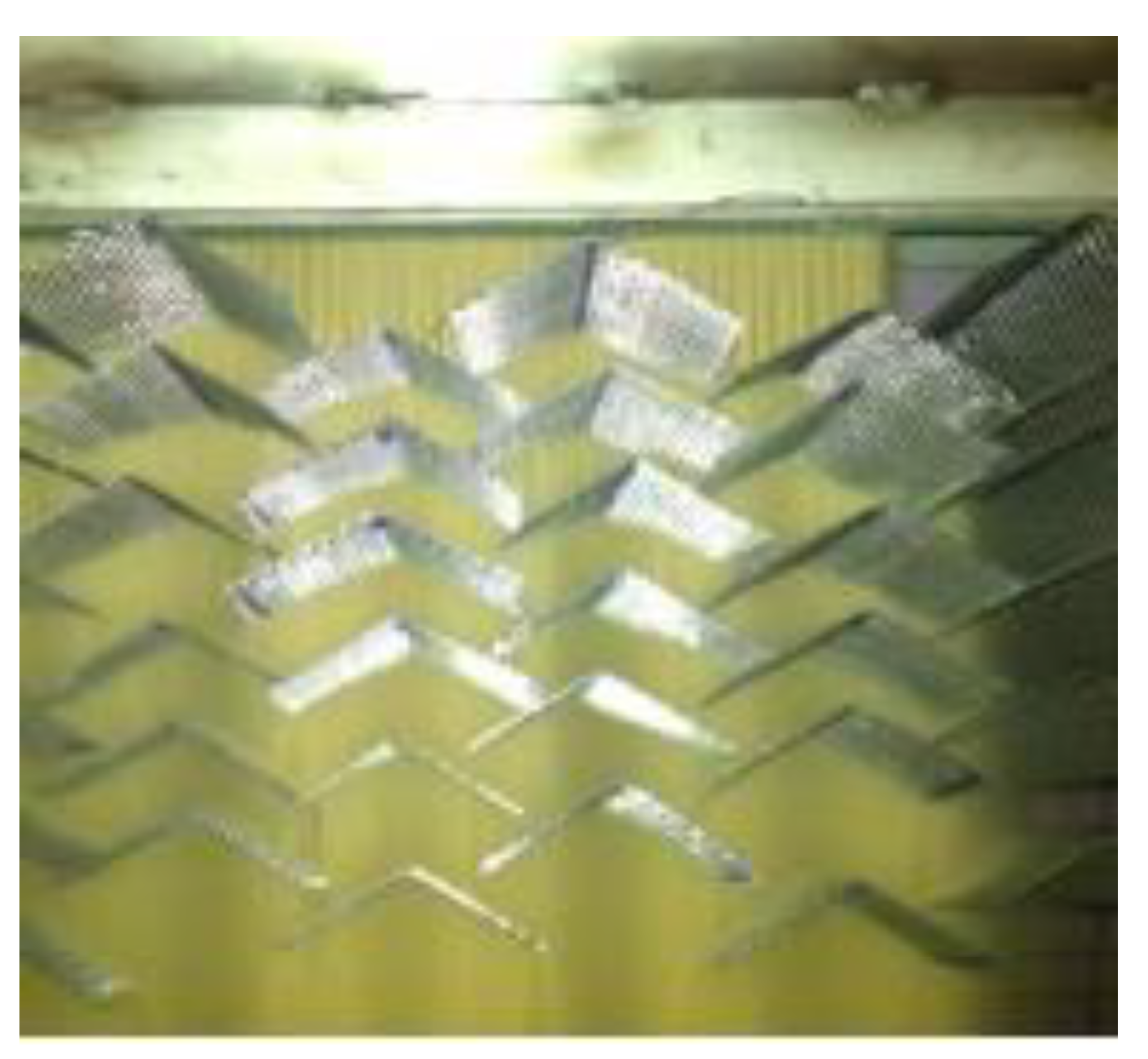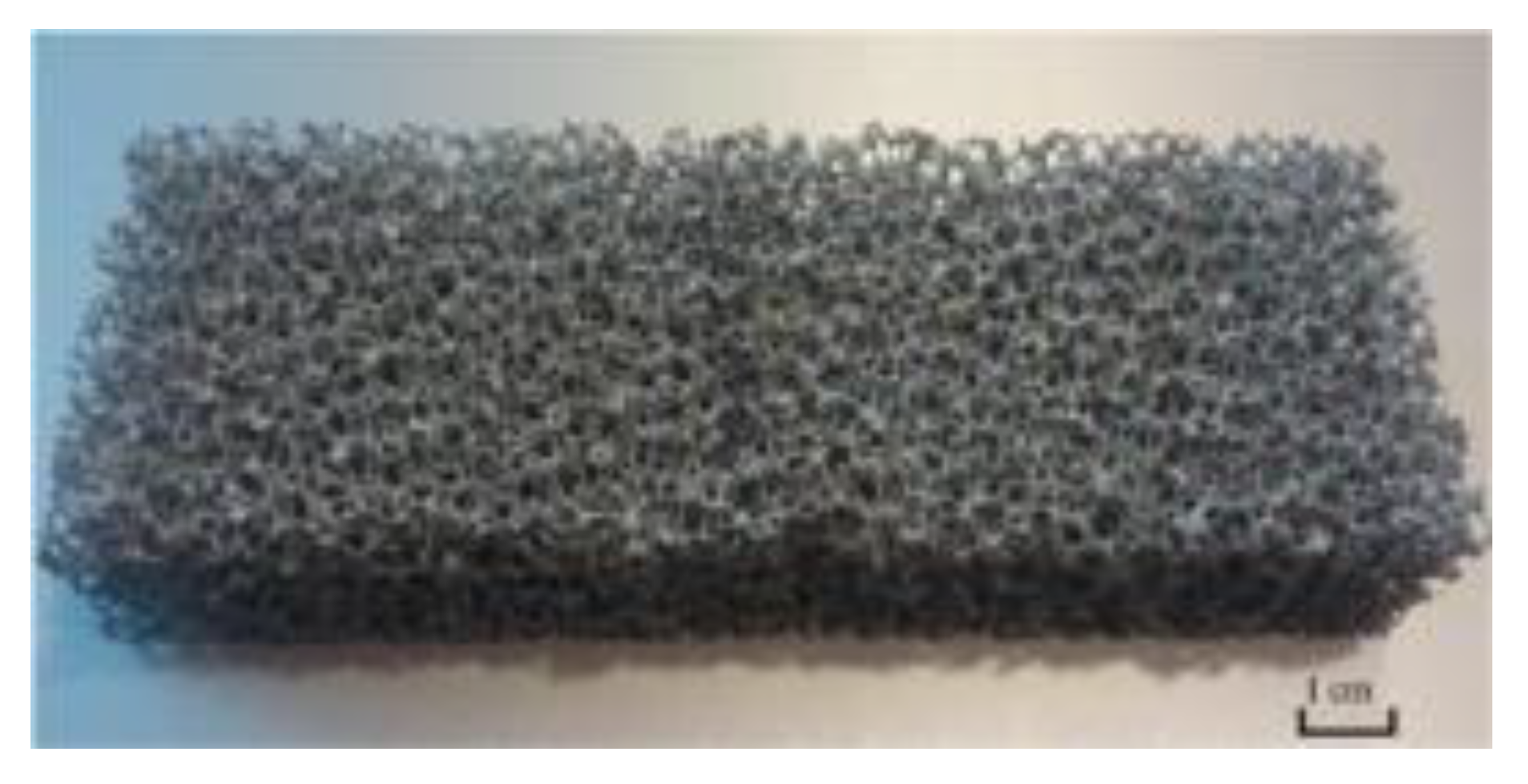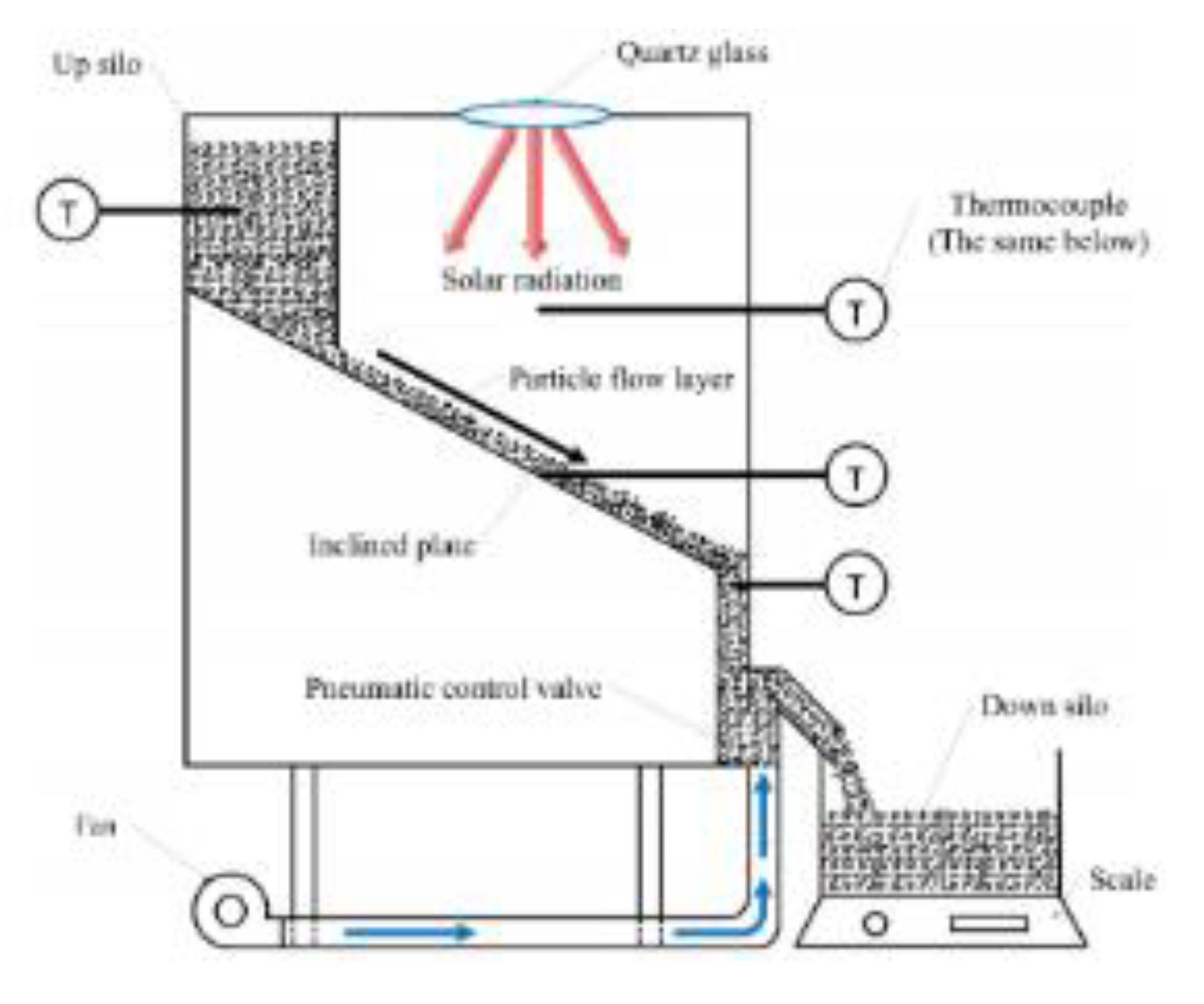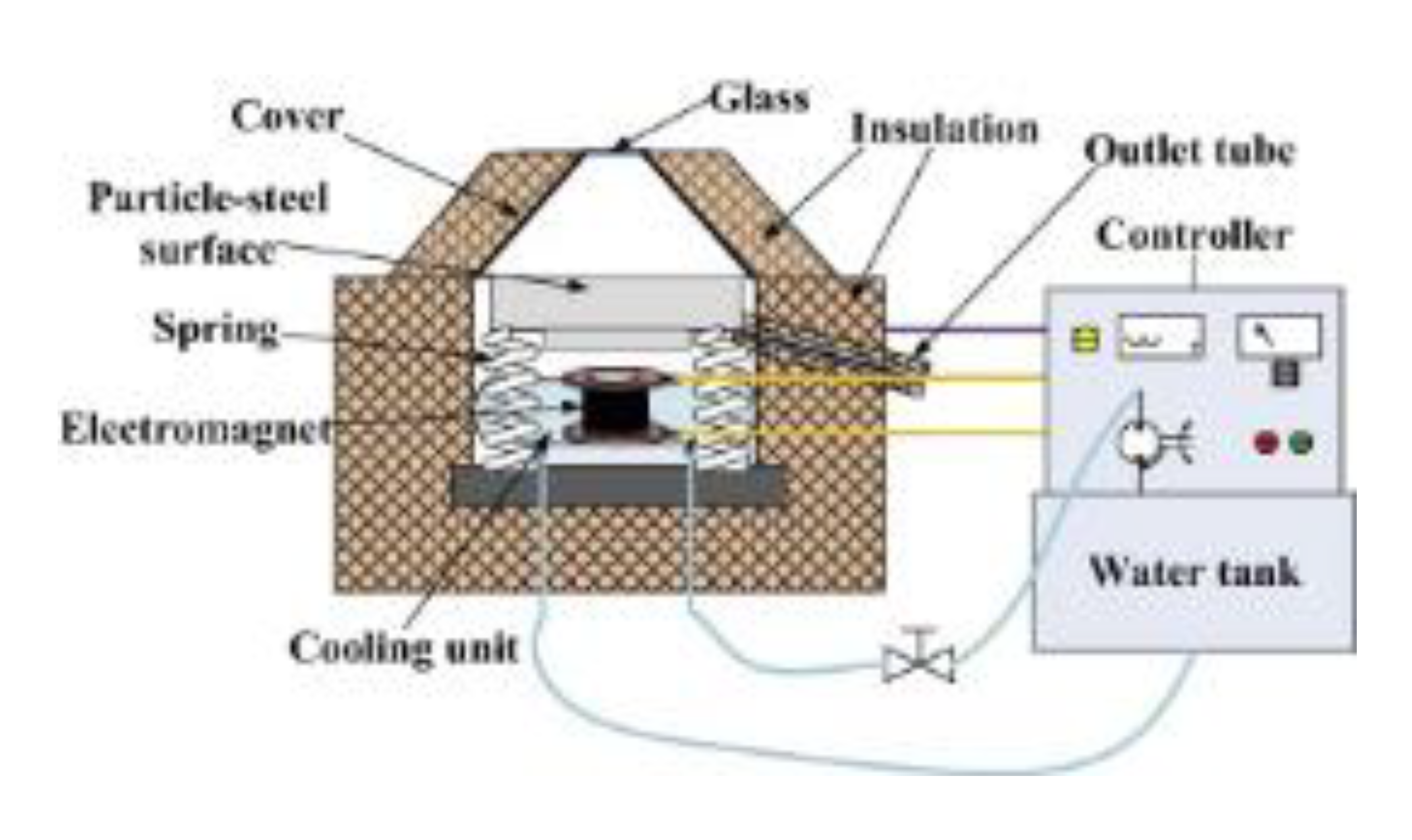Abstract
Concentrated solar thermal (CST) systems are pivotal in the pursuit of renewable energy solutions to meet emissions reduction targets. They play a vital role in addressing the negative impacts of energy-intensive industrial processes, such as the high-temperature calcination step in the alumina Bayer process, requiring temperatures of approximately 1000 °C. However, achieving such high temperatures poses challenges, as radiative losses increase significantly with temperature. Current commercially available CST technologies, employing heat transfer mediums like molten salts, are constrained to temperatures below 600 °C. The emerging focus on sand-like ceramic particles, either as standalone materials or in suspension within an air stream, as heat transfer mediums signifies a promising avenue in the development of high-temperature receiver-based CST technologies. These particle-laden suspension flow receiver systems have the potential to reach operating temperatures exceeding 1000 °C. This review paper provides a comprehensive overview of CST technologies, with a primary focus on high-temperature particle receivers. It sheds light on the existing challenges within the CST state-of-the-art technologies and introduces the concept of refractory-lined particle receivers. This paper also underscores the significance of transient-based thermal analysis for high-temperature particle receivers and highlights the necessity of such analyses to guide their practical implementation. By addressing these critical aspects, this review paper contributes to the advancement of CST technologies, emphasizing their role in achieving sustainable, high-temperature heat for emission reduction objectives.
1. Introduction
Solar energy stands out among the other alternative energy sources that have the potential to replace high-carbon-dioxide-emitting fossil fuels. This source of renewable energy is sustainable and inexhaustible, unlike finite fossil fuels. It has been predicted that the amount of solar energy falling onto the surface of the earth in just one hour could fulfil global energy needs for one year, but this requires the right technologies to effectively capture and utilize this renewable source of energy [1]. The intermittent nature of solar resources creates a big challenge for solar energy utilization, especially for large-scale applications, which require a continuous supply of energy [2]. In this regard, concentrated solar thermal, CST technologies are gaining importance as an alternative, clean, and renewable energy source [3,4,5,6]. These are considered a suitable alternative to primary fossil fuels due to their potential to meet the load demands of both high- and low-temperature process heat applications [7]. Furthermore, thermal energy storage can be integrated into a CST plant to overcome the intermittency issues related to solar energy and increase the operational reliability of the system.
Despite the potential of CST technologies as a source of heat and alternative to fossil fuels for industrial processes [8], new CST technologies are required to achieve operating temperatures of 1000 °C or above, as this temperature is typically required for thermochemical processes such as the calcination involved in the alumina Bayer process [9]. This is because the current commercially available CST technologies have temperature limitations in the heat transfer medium, which are molten salts. The most commonly used molten salts, such as molten nitrate solar salt (60% NaNO3 and 40% KNO3), have a safe working range from 220 to 565 °C, and they are more prone to corrosion [10,11]. They freeze below 220 °C and become chemically unstable above 565 °C, requiring trace heating and limiting the operation of CST technology to below 600 °C [12]. This eliminates the integration of CST into heavy industrial processes requiring high temperatures (>1000 °C), such as steel, aluminium, and cement manufacturing, which contribute ~15% of global CO2 emissions [13,14]. In Australia, the industrial processes contribute ~42% of CO2 emissions, and ~220 PJ/year is consumed by alumina refineries alone, of which 67% is supplied using natural gas [15,16]. Also, these processes are hard to abate as they make a huge contribution to the economy. Australia generated USD 8 billion from the alumina industry in 2018 [16]. Therefore, further technical assessments of new or existing CST technologies with the ability to achieve higher operating temperatures, as well as a better trade-off between thermal performance and operating temperature, than commercially available options are required.
To overcome the limitations of the present CST systems, particle-laden systems are being pursued for next-generation CST plants with operational temperatures >1000 °C [10]. Recent technological innovation in the field of concentrating solar energy is opening new potential markets that can be considered in terms of their viability. In particular, high-temperature particle receivers are being developed to achieve temperatures in the order of 1000 °C for advanced power cycles and solar thermochemical processes [17]. The use of particles as primary HTFs or in suspension within an air stream to enhance the heat transfer to the gas phase has the potential to achieve temperatures of around 1000 °C and improve the performance of the solar receiver systems, lowering the cost of energy [18]. Also, the wide range of operating temperatures makes these receivers an enabling technology for scalability [18,19]. There are different promising concepts of particle-laden receivers, including falling particle receivers devised by the Sandia Laboratory [20,21,22], a centrifugal receiver devised by the German Aerospace Center (DLR) [23,24,25,26], and tubular fluidized beds devised by the French National Centre for Scientific Research (CNRS) [27]. The use of particles as the heat-transfer and storage media is unique [28]. The basic difference between a high-temperature particle receiver and other commonly used central receivers is that it utilizes a directly irradiated cavity enclosure, which helps the particles, whether alone or in suspension within an air stream, to achieve a higher temperature and better conversion efficiency [29].
One class of suspension flow solar particle receiver technology that has received significant attention employs direct irradiation to heat a vortex of air and particles in a cylindrical cavity, known as the solar expanding-vortex receiver (SEVR). This configuration of the receiver has the potential to act as an air heater, with the option of using suspended particles to reheat returned air from the integrated storage, which is already at an elevated temperature (>300 °C). Although high-temperature particle-laden receiver technology has the potential to achieve operating temperatures of over 1000 °C, the performance of these directly irradiated receivers needs to be assessed based on their transient operation using real-time solar irradiance data. Also, the operating temperature above the melting temperature of mild steel requires the use of refractory linings, similar to non-solar rotary kilns, or expensive high-temperature metals. The use of refractories allows the operating temperature to exceed 1000 °C, but these are brittle and have high thermal mass. This makes the transient response of a refractory-lined directly irradiated receiver more challenging than those of tubular receivers. This highlights the need for heat and mass transfer models to understand the influence of long-term solar transients on the thermal performance of these particle-laden receivers.
The practical implementation of refractory-lined solar receivers requires greater insight into the potential approaches required to manage the transient heat inputs. This is because the high thermal inertia of the refractory lining can potentially result in a significant fraction of the solar resource being needed to heat the cavity to the required operating temperature. While refractory-lined solar receivers are expected to have longer start-up time, little attention has been paid to the means through which this time might be reduced when considering long-term solar resource variability [30]. Hence, there is a need to better understand the start-up behavior of these receivers and the potential options through which the start-up time might be reduced, considering the influence of transients in the incoming concentrated solar radiations [31,32,33]. Insufficient information being available to guide the selection of the refractory type, thickness, or management strategy in response to these challenges provides further motivation for the present research project.
The integration of high-temperature solar central receiver systems has been reported in the literature, albeit only for the generation of electricity using steam and gas turbine cycles [34,35,36,37,38,39,40]. There are limited studies of the use of integrated systems to produce high-temperature heat, i.e., above 1000 °C, for heavy industrial applications such as the production of alumina. Also, the integration of new technologies and concepts, such as refractory-lined suspension flow systems, is more challenging to customize and requires physical models of the sub-systems, which are able to predict the transient system behavior, to change the design and operating parameters. This highlights the need to perform a system analysis by integrating the physical sub-models into heat and mass transfer equations for each component to understand their combined performance, considering site-specific solar variability. Further, the combined effects of key design parameters on the thermo-economic performance these high-temperature CST systems, considering transient losses through a year of operation at a potential plant site, are still unclear. Hence, there is a need for an assessment that provides a new understanding of the system-level performance of these CST systems, along with a preliminary assessment of the levelized cost of the solar component of the energy. This paper aims to fill these gaps.
To summarize, new insights are required regarding the best ways to enhance the thermal performance of high-temperature CST technologies when operating under transient inputs, such as through the use of refractory linings in central receivers and the introduction of particle-laden flows into a receiver cavity. Furthermore, there is a need to understand the performance of a refractory-lined solar receiver operating in combination with thermal storage and other components of a CST system, with the option of a backup burner, to supply high-temperature heat to a downstream process. Although high-temperature particle-laden receiver technology has the potential to achieve operating temperatures of over 1000 °C, due to the variable nature of solar energy resources and higher thermal mass associated with these receivers, their performance needs to be assessed based on their transient operation using real-time solar irradiance data. The importance of and need for transient-based thermal analysis of high-temperature particle receivers for their practical implementation are highlighted in this review paper.
2. CST to Power Industrial Decarbonization
Carbon dioxide (CO2) emissions are increasing at a rapid rate due to rising energy consumption being required to fulfill different commercial and residential needs. These emissions are a major contributor to global warming and climatic changes. Global CO2 emissions related to the energy sector increased to the highest recorded value of 36.3 Gt in 2021, as can be observed from Figure 1 [41,42]. About 90% of total CO2 emissions occur because of the burning of fossil fuels for power generation and use in the transport sector [41,43]. Consequently, it has been projected that CO2 emissions from energy-related processes will double by 2050 [43]. The progressive increase in these harmful emissions is causing environmental imbalances, such as extreme weather conditions, around the world. Meanwhile, the prices of diminishing fossil fuels are increasing rapidly and projected to further rise in the next 20 years. Furthermore, the gap between energy supply and demand is expected to widen due to this rapid increase in global energy demand [41,43,44]. Many developing countries around the world are already facing a deficiency of power because of this increasing demand and supply gap. The issues associated with the excessive use of fossil fuels for different commercial and industrial applications require the development and implementation of new technologies that are both environmentally friendly and cost-effective. In this regard, concentrated solar thermal (CST) technologies are gaining importance as alternative, clean and renewable energy sources, particularly in regions with higher solar irradiance [3,4,5]. The growth in solar thermal installed capacity has shown an encouraging trend over the last few years, as depicted in Figure 2 [45,46], with greatest share of growth gained by Spain, the US, China, South Africa, and Morocco [47]. Despite some of the positive indicators noted, more work is required to increase the share of this vast renewable energy technology, especially for high-temperature heat applications.
CST technologies are considered a suitable alternative to primary fossil fuels due to their potential to meet the load demands of both high- and low-temperature applications. The CST can be integrated into a high-thermal-energy storage system, which can be used during the night or on cloudy days, to supply the required input energy and overcome solar intermittency issues. Presently, CST technologies are commercially available for power production in the lower temperature range, i.e., less than 600 °C [48]. There is a push to develop solar thermal technologies for use in higher temperatures than currently commercially available to integrate them into processes requiring higher temperatures, such as the alumina Bayer process, which requires an operating temperature in the order of 1000 °C [9]. In this regard, solar particle-laden (suspension flow) receivers are a promising class of technology for operating at high temperatures, i.e., above 1000 °C [23,24,49,50]. This receiver technology employs sand-like ceramic particles as heat transfer fluids, as standalone elements, or in suspension within an air stream, which are stable at such high temperatures and cost-effective [23,24,49,51]. These receivers can help to overcome the issue of temperature limitation associated with other commonly used heat transfer fluids, such as molten salts and oils [27].
Recently, Rafique et al. [2,16,33,48] made a noteworthy contribution to the assessment of refractory-lined solar receivers for high-temperature industrial processes. Their study introduced a comprehensive approach to analysing and optimizing the thermal performance of a refractory-lined particle receiver in response to solar resource variability. The study extended its impact by conducting a detailed examination of time-dependent temperature fields within the receiver cavity. Furthermore, the thermal response of a multilayered refractory-lined solar receiver was investigated across critical operational phases, encompassing start-up, turn-down, and shut-down scenarios for both cold and hot starts. The study went further by evaluating the annual thermal performance of a cutting-edge CST technology featuring the solar expanding-vortex receiver. Noteworthy insights emerged, shedding light on the influence of refractory materials in particle-laden receivers, the efficacy of potential operating controllers in terms of mitigating solar variability effects, and the impacts of particle loadings and heat transfer medium temperatures on the system’s overall thermal performance throughout the year. The research culminated in a demonstrated approach for analysing and optimizing a high-temperature CST plant by utilizing a particle-laden receiver and sensible thermal storage.
Despite the above strides made in advancing the understanding of refractory-lined solar receivers, it is essential to stress that this field still presents avenues for further exploration and research. The complexity of solar receiver systems, particularly in the context of particle-laden receivers and high-temperature CST plants, calls for continued investigations. Future research endeavors could delve into refining mathematical models, considering additional parameters, and expanding their scope. Moreover, there remains a need for comprehensive studies that integrate advanced control strategies to enhance the adaptability of refractory-lined receivers to dynamic solar conditions. The development of novel materials with improved thermal characteristics, coupled with a deeper exploration of their behavior under varying operational conditions, is also an area that requires further investigations. As the field of solar energy continues to evolve, ongoing research efforts will be crucial in terms of advancing the efficiency, reliability, and overall performance of refractory-lined solar receivers, ultimately contributing to the broader goal of achieving sustainable and efficient solar power utilization.
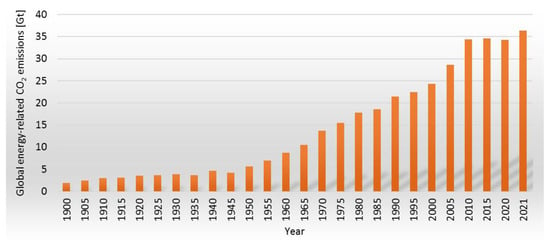
Figure 1.
The global trend of energy-related CO2 emissions: 1990–2021. Data were taken from [42,43,52].
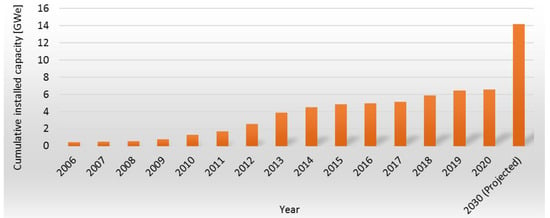
Figure 2.
The growth in global cumulative installed solar thermal power [45,46].
3. Central Receiver Technology
The four most common types of CST technologies include the linear Fresnel reflector, parabolic trough, central receiver, and parabolic dish, as illustrated in Figure 3 [53]. Among these technologies, the parabolic trough is the most mature technology, and it has an 80% share of the total operational solar thermal plants worldwide, as can be observed in Figure 4 [40]. The operating temperature of the central receiver technology is higher in comparison to other CST technologies. This enables central-receiver-assisted systems to achieve higher thermal efficiency and better overall performance [19,50]. Different types of central receiver technologies have been investigated depending on the type of heat transfer fluid used, including liquid-, gas-, and solid-based receivers [50].
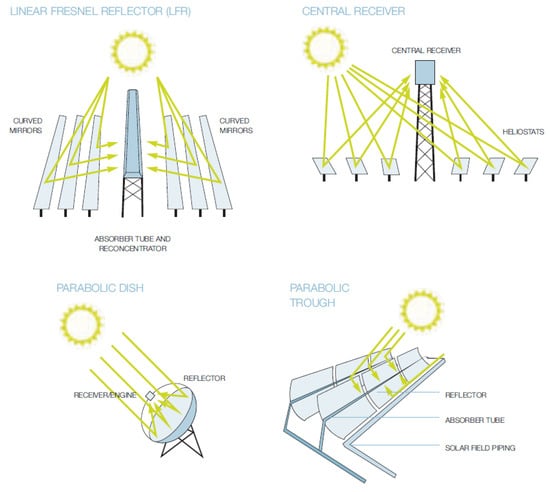
Figure 3.
An illustration of commonly used CST technologies. Adapted from [53].
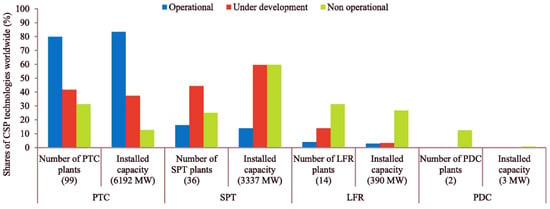
Figure 4.
An illustration of the worldwide share of different CSP technologies, including the parabolic trough collector (PTC), solar power tower (SPT), linear Fresnel reflector (LFR), and parabolic dish collector (PDC). Adapted from [40,47]. The data presented are for 2020.
3.1. Molten Salt Receivers
Presently, the central receiver technology mostly uses molten nitrate salts as heat transfer fluids, but due to the chemical instability of these salts, their operation is limited to temperatures below 600 °C [54]. Table 1 provides a summary of the most commonly used molten salts and their stable temperature ranges [55,56,57]. These salts become chemically unstable above 600 °C, resulting in the production of corrosive oxide ions, and can cause excessive loss of heat transfer fluid [54,58]. This limitation in the operating temperature is not in line with the motivation driving CST technology development, which is to achieve higher operating temperatures, lower thermal losses, and lower associated system costs. Furthermore, chemical instability at higher temperatures limits the use of CST technology for different industrial processes, such as the calcination process, which requires an operating temperature of ~1000 °C.

Table 1.
A summary of the most commonly used molten salts and their stable working temperature ranges [55,56,57].
3.2. Gas Receivers
The use of gases, such as air, helium, and CO2, in central receivers is also a promising concept. The gas employed as a heat transfer fluid is used either inside the tubes (tubular receiver, Figure 5a) or through a structure of honeycomb channels (volumetric receiver, Figure 5b). In both tubular and volumetric receivers, air is heated to a higher temperature, which is then used for a process, or heat is stored in a secondary media for later use [50]. Tubular receivers are characterized by cylindrical tubes facilitating fluid flow, offer modularity, and durability. On the other hand, volumetric receivers, utilizing a cavity for direct solar absorption, excel at ensuring high thermal efficiency and uniform heating. Their direct absorption of solar energy makes them well-suited for use at elevated temperatures, although considerations for high-temperature-resistant materials are crucial. When deciding between the two options, factors such as system efficiency, maintenance requirements, and the desired temperature range should guide the decision. The literature reveals that volumetric air receivers have the potential to achieve temperatures of above 700 °C [8,59]. The German Aerospace Center (DLR) assembled an innovative 200 kW high-temperature volumetric air receiver, with hexagonal-shaped modular ceramic absorbers, and reached a maximum outlet air temperature of 980 °C, achieving a thermal efficiency of 68% [60]. Buck et al. [61] tested a windowed volumetric air receiver with a secondary concentrator for a hybrid gas turbine unit and reported a thermal efficiency of 70% at a peak operating temperature of 815 °C. Recently, Patil et al. [8] experimentally tested a 5 kW volumetric air receiver containing a reticulated porous ceramic structure and reported a nominal thermal efficiency of 69% at an output air temperature of 1133 °C. Similarly, Pritzkow [62] reported a maximum output air temperature and thermal efficiency of 1050 °C and 71%, respectively. Furthermore, the numerical model of the volumetric receiver employed by Stadler et al. [63] showed that these receivers have the potential to achieve peak efficiencies of 70.9% with an output air temperature of 650 °C. Some details of these high-temperature volumetric air receivers are provided in Table 2, whereas a comprehensive summary of volumetric receivers was previously provided by Ho and Iverson [64] and Ávila-Marín [65]. Most of these cavity air receivers employ an aperture window to lower the heat losses which is a critical component that is more prone to failure and increases the maintenance costs [66], in a scale-up design of the receiver operating beyond 1000 °C.
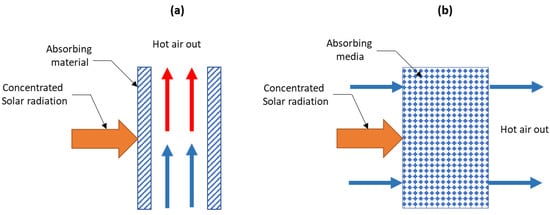
Figure 5.
A schematic diagram of a (a) tubular receiver and (b) volumetric receiver.
Although these air receivers have previously been widely reported for use in pursuit of high temperatures [8,59,64,65], inferior heat transfer properties are a challenge for their upscaling. In this regard, the use of solid particles in suspension within an air stream has the potential to increase the effectiveness of the heat transfer mechanisms within the receiver cavity due to their high surface area per unit mass and capacity for the direct absorption of concentrated solar radiations [67]. However, this requires further investigation of the quantitative benefits achieved through the addition of particles into the air stream.

Table 2.
An overview of volumetric receivers from the point of view of operating temperature and pressure, absorber material, and thermal efficiency.
Table 2.
An overview of volumetric receivers from the point of view of operating temperature and pressure, absorber material, and thermal efficiency.
| References | Operating Temperature | Operating Pressure | Thermal Efficiency | Thermal Scale | Type of Study | Absorber Type |
|---|---|---|---|---|---|---|
| Patil et al. [8] | 1133˚C | atm | 0.69 | 5 kW | Experimental | Reticulated porous ceramic |
| Hoffschmidt et al. [60] | 980˚C | - | 0.68 | 200 kW | Experimental | Modular ceramic |
| Buck et al. [61] | 815˚C | 5.2 bar | 0.70 | 410 kW | Experimental | Heat-resistant wires |
| Pritzkow [62] | 1050˚C | 5.2 bar | 0.71 | 5 kW | Experimental | Ceramic foam absorber (Si3Ni4) |
| Stadler et al. [63] | 650˚C | atm | 0.71 | - | Numerical | Ceramic honeycomb |
| Karni et al. [68] | 800˚C | 25 | - | 10 kW | Experimental | - |
| Chavez and Chaza [69] | 550 °C | - | 0.65 | 800 kW/m2 | Experimental | Porous ceramic absorber |
| 730 °C | 0.54 |
3.3. Particle-Laden Receivers
Several developments and research works are underway to develop CST technologies to overcome the above-mentioned issues and effectively replace the use of fossil fuels in different high-temperature applications. One advancement towards achieving the CST development goal is the use of solid particle-based solar receivers, in which ceramic particles, alone or within a vortex of air, are used as heat transfer fluid [70]. These receivers have the potential to achieve a temperature above 1000 °C as particles come into direct contact with the solar radiations, and there is no extra resistance from tubing for heat transfer [71,72]. Furthermore, the materials used for these receivers are more stable and less expensive relative to molten salts [73]. Much work related to particle-laden receivers exists in the literature, including the design of the receiver, mathematical modeling, and the testing of pilot plants [23,24,49].
Martin and Vitko [74] used solid particles in central receiver technology for the first time at the Sandia National Laboratories. They used pebbles and sand for applications requiring temperatures above 600 °C. Siegel and Kolb [75] found that under an average solar irradiance of 800 kW/m2, a solid particle temperature of over 900 °C can be achieved using multiple cycles. Ho et al. [76] revealed that particle-based receiver technology is well suited to systems with a capacity ranging from 10 to 100 MW, which are being designed for applications requiring temperatures above 700 °C [20,21,28,77,78,79,80,81], with a further aim of achieving above 1000 °C. The potential advantages offered by solid particles used in central receiver technology are summarized as follows:
- They are not chemically active and are stable at higher temperatures above 1000 °C. Also, these particles have no issue with freezing, which eliminates the trace heating requirements.
- They have the ability to store energy as heat over a wide temperature range, which increases their storage density.
- They are cheaper in comparison to the most commonly used heat transfer fluids.
- They are more flexible and can be integrated into a wider number of applications, such as power generation, thermochemical processing, fuels, heat storage, and process heat.
- They can help to reduce the cost of storage as heat is directly stored in the sand like ceramic particles.
- The inert nature of these particles offers the flexibility, based on the process side requirement, to be used as a standalone heat transfer medium or in suspension within a gas stream to enhance the heat transfer mechanism.
A summary of the benefits and drawbacks of gas-, liquid-, and solid-based receivers has been listed in Table 3. Adapted from [80,81], a comparative analysis of a molten salt-based and solid particle-based receivers with capacities of 50 MWth is presented in Table 4. It can be observed that the solid particle-based receiver can achieve a higher temperature and thermal efficiency, along with requiring less storage volume.

Table 3.
Benefits and drawbacks of gas-, liquid-, and solid-based receivers.

Table 4.
Comparison between operating parameters of molten salt and solid particle solar receivers with 50 MWth capacities [80,81].
High-temperature particle receiver technology has the potential to achieve operating temperatures of over 1000 °C, but the performances of these receivers need to be assessed based on their transient operation using real-time solar irradiance data. The transient approach has been used for indirectly irradiated receivers [82,83] but has not been employed for directly irradiated high-temperature particle-laden receivers. This highlights the need to address that how high-temperature particle-laden receivers will behave during start-up, turn down, and shut down periods and under unsteady conditions, as well as how the thermal performances of these receivers are affected under transient operation, considering the variable nature of solar resources.
4. High-Temperature Particle Receiver Designs
Different types of particle-laden receiver designs have been investigated for achieving better performance by reducing thermal losses and achieving higher operating temperatures [25,84,85,86]. The most widely investigated designs include free-falling [87,88,89], obstructed flow [71], and centrifugal [23,24,25,90] and tubular receivers (fluidized) [91,92,93], which are illustrated in Figure 6. The basic design of particle-laden receiver technology is the falling particle receiver, which has been studied both analytically and experimentally [88,89]. Each design of these high-temperature receivers is investigated by implementing various geometric configurations to improve the achievable temperature and thermal efficiency [94]. Siegel et al. [20] achieved a thermal efficiency of 50% by performing one of the first on-sun tests of a simple free-falling particle receiver. Ho et al. [87] concluded that the thermal efficiency and achievable output temperature are strongly dependent on the mass flow rate through a receiver and solar irradiance. Higher thermal efficiency is achieved through an increase in the particle mass flow rate, but the outlet temperature decreases [87]. The obstructed or recirculating design can achieve higher outlet temperatures due to the increased residence time [95]. Ho et al. [87] concluded that the continuous circulation of particles will increase the particle outlet temperature to over 700 °C, with a thermal efficiency of 50–80%.
Using the primary concept of these designs, researchers have considered different configurations to be used for the particles in central receiver technologies. These secondary designs include placing a V-shaped mesh [96], a porous structure [97], an inclined plate [98], and spiral tubes [99] inside a receiver cavity to increase the residence time of particles to ensure higher absorption efficiency. The main characteristics of these configurations are described in Table 5.

Table 5.
The secondary configurations of particle receivers studied using primary designs.
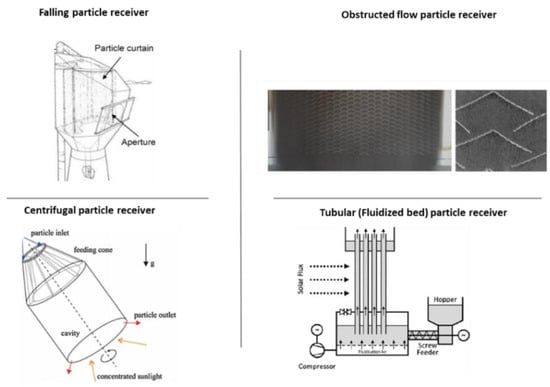
Figure 6.
The basic designs of particle receiver technology. Adapted from [93,100].
4.1. Cylindrical Cavity Receivers
A directly irradiated particle-laden receiver utilizes a cavity enclosure to contain concentrated solar radiations and reduce the thermal losses [6]. The purpose of the cavity receiver is to direct the reflected solar radiations from the heliostat field to the heat transfer fluid contained in a box or cylindrical shape through an aperture, as shown in Figure 7. One type of cavity receiver that has gained particular attention in recent years forms a vortex of particles inside a cylindrical cavity using a carrier gas. Concentrated solar radiations through the aperture directly heat a vortex of particles. This type of cavity receiver is commonly known as a solar vortex receiver (SVR) [101]. The basic design of a SVR is shown in Figure 8 [67]. SVR comprises an aperture covered by a quartz window placed normally in relation to the cavity axis, through which concentrated solar radiations fall onto the particles, being injected tangentially along with a gas to form a vortex. The heated particles and gas exit from the rear along the axis of the cavity [102,103]. Due to the formation of a vortex, the heat transfer medium absorbs more solar radiation falling through the aperture and helps to achieve better mixing inside the receiver cavity.
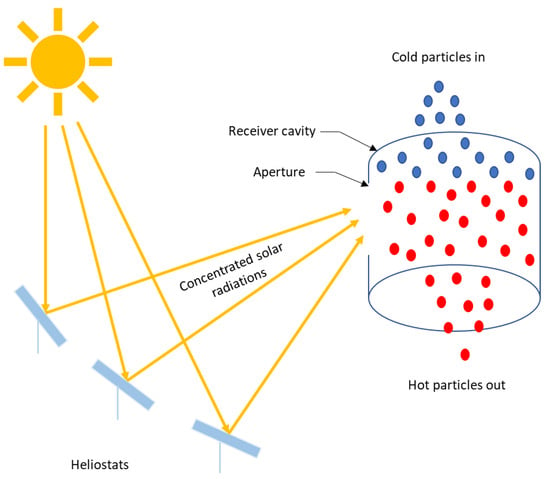
Figure 7.
A schematic diagram illustrating the basic design of a cavity receiver.
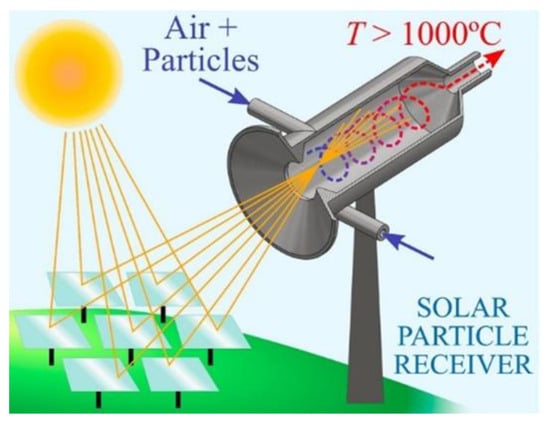
Figure 8.
The basic configuration of a SVR adapted from [67].
Theoretical and experimental studies have been carried out for cylindrical cavity receivers, and most of them have shown the advantage of achieving better heat transfer to the particle-laden flow [9,104]. The output temperature in the order of 1000 °C can be achieved using these receivers, and they have the flexibility to be configured in different ways [9]. Z’Graggen et al. [102,105,106] reported a carbon conversion efficiency of 87% from the laboratory scale testing of a 5 kW solar receiver for hydrogen production via steam gasification. The solar cavity was directly injected with petcoke water slurry to form a vortex inside the cavity, which was directly exposed to the solar radiation falling through the aperture covered by a glass window.
Numerous studies of high-temperature cavity receivers have used a rather complex computational fluid dynamics (CFD) method to study the effects of different geometric parameters and operating conditions on their performance. Xiao et al. [107] numerically and experimentally analyzed a cylindrical cavity receiver using a two-stage solar dish reflector via which the sun rays were reflected twice before reaching the aperture. The particles inside the receiver moved into a spiral shape and were heated through the solar irradiance directly falling onto them. The spiral movement of the particles increased their residence time to achieve higher thermal efficiency. The results of the study revealed that with an average solar flux of 150 kW/m2, a particle temperature of up to 1100 °C can be achieved. Meier [88] employed a CFD computational tool to analyze a 1.5 MW cavity receiver for limestone decomposition. The study revealed that an output temperature of >900 °C can be achieved with a solar flux of less than 1000 kW/m2. Ozalp et al. [108,109,110] analyzed the flow features and temperature distributions in a solar cavity receiver–reactor. Similarly, Dai et al. [111] also employed the CFD simulation tool to analyze the effects of different operating and geometric parameters on the performance of a 10 kW SVR for CO2 coal gasification. These CFD studies have significantly contributed to investigating the flow features inside a cavity receiver, but the influence of solar transients on the long-term thermal performances of these receivers, considering start-up, turn down, and shutdown periods, is still unknown.
Some analytical models have also been developed for high-temperature particle-laden receivers [67,112,113], but these have not considered the transient effect on the annual thermal performance. A recent study by Davis et al. [67] employed a steady-state analytical model developed for a cylindrical cavity high-temperature particle receiver to observe its thermal performance under varying operating conditions. The authors assumed a constant solar flux of 2000 kW/m2. It was revealed that the vortex receiver has the potential to achieve a thermal efficiency of up to 88%. Although these vortex-based receivers have high conversion efficiency, they have two major drawbacks, which are as follows [108]:
- The residence time is independent of the particle size, which may result in the overheating of smaller particles and underheating of larger ones. This will cause a decrease in the overall thermal performance of an upscaled receiver.
- Higher particle deposition on the aperture window lowers the receiver’s thermal performance and can generate a risk of window failure, resulting in higher operating costs. We noted that the overall cost of a quartz glass window for high-temperature receivers is too high (reported to be in the order of USD 10 million [114]) due to the need for high transmittance and a large area when upscaled.
4.2. Solar Expanding-Vortex Receiver
To overcome the drawbacks associated with the SVR, Chinnici et al. [29,115,116] presented a new configuration of a cylindrical cavity receiver known as the solar expanding-vortex receiver (SEVR), which is shown in Figure 9. This novel configuration has a modified geometry, with the introduction of a conical section. The particles and air exit in the direction that is radial to the axis of the receiver cavity. The residence time is dependent on the particle size in this new configuration, which helps to achieve a uniform outlet temperature. This configuration is also helpful for avoiding the deposition of particles onto the aperture window. The authors evaluated the effect of receiver geometry on the particle trajectories and residence times using a CFD model [29]. Furthermore, a particle’s deposition onto the aperture window was also assessed both experimentally and numerically [115]. It was found that for a fixed aperture size, an increase in the cone angle is favorable as it generates a larger vortex at the aperture plane. This is why a larger cone angle is favorable for smaller size particles, as it will lower the particle flowing toward the aperture. The optimum value of the cone angle was predicted to be 40° for the studied conditions. Chinnici et al. [115,116] further confirmed that a well-established vortex flow inside the cavity is generated via the SEVR. It was also found that a reversed flow formed in the vortex core region, whereas at the inlet and outlet regions of the cavity, a processing vortex core (PVC) structure was observed, as shown in Figure 10 [116].

Figure 9.
A simplified configuration of SEVR adapted from [29].
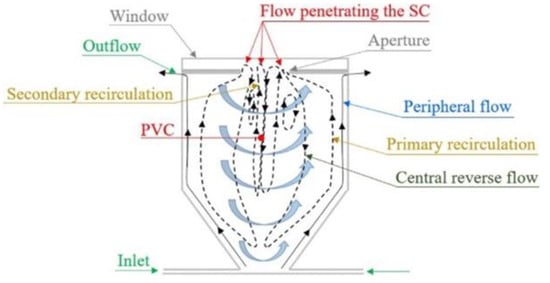
Figure 10.
An illustration of flow patterns within a SEVR adapted from [116].
A summary of recent studies of high-temperature particle-laden receivers is presented in Table 6, whereas Figure 11 summarizes the configurations of particle-laden receiver technologies available in the literature. Figure 12 summarizes the advantages and challenges associated with some of the most widely investigated particle-laden receiver configurations, including the free-falling particle receiver [18,20,22,76,77,78,79,87,88,117,118,119,120,121,122,123,124,125,126,127,128,129,130,131], centrifugal receiver [23,24,25,26,132,133], solar vortex receiver [67,102,105,106], solar expanding-vortex receiver [29,115,116,134,135], Λ-plate meshed receiver [50,95,96,136,137], porous structured receiver [97,138,139,140], inclined plate receiver [98,141,142], and fluidized bed receiver [143,144,145]. The detailed development of different high-temperature receiver technologies was previously reviewed by Achkari et al. [47], He et al. [45], Zhu et al. [146], Islam et al. [51], Tan et al. [49], Ho and Iverson [64], Jiang et al. [114], Behar et al. [4], and Merchán et al. [40].

Table 6.
A summary of recent studies on high-temperature particle-laden receivers.
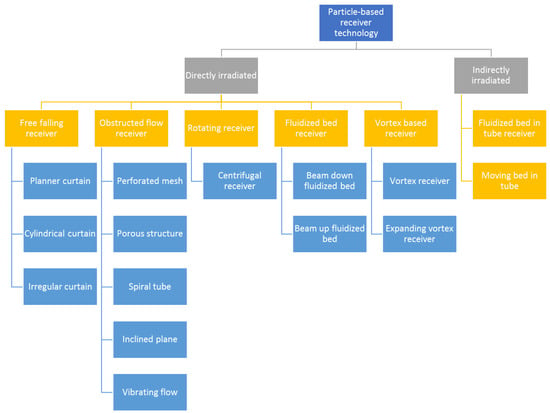
Figure 11.
A summary of the classification of particle laden-receiver technologies discussed in the literature.
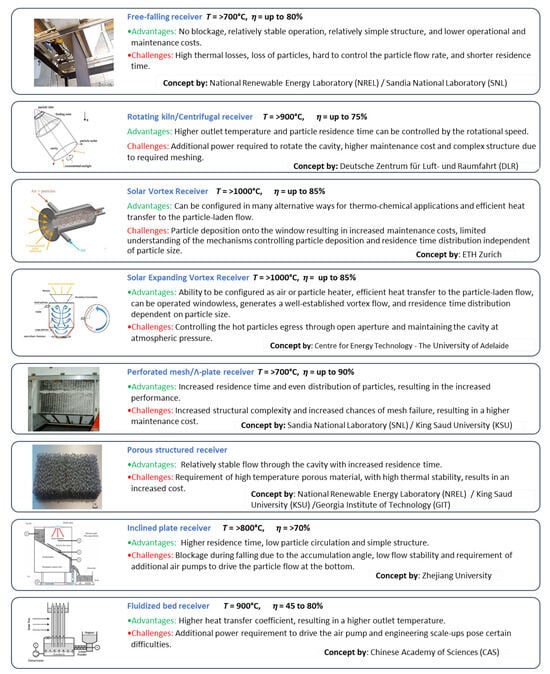
Figure 12.
A summary of the advantages and challenges associated with the different particle-laden solar receiver technologies reported in the literature. Here, T and η refer to the maximum reported value of output temperature and thermal efficiency, respectively.
While the above-mentioned studies have analyzed the thermal performances of high-temperature particle-laden receivers and indicated their potential advantages, they have not considered the transient effect on the receiver thermal performance. The solar flux changes significantly from one location to another, which means that the actual performance of the receiver can only be assessed based on the real-time climatic conditions of each location, considering transient losses. The distribution of minutely, hourly, daily, and monthly DNI for a specific location significantly varies [2]. Saw et al. [2] mentioned that the performance estimation of solar technologies based on average monthly or daily data can have an uncertainty of 20–30%. This is why hourly or minutely performance evaluation is recommended to ensure a reasonably good estimation of system performance. Therefore, the transient performances of the high-temperature particle-laden receivers need to be assessed based on the actual solar DNI data for a specific site. This requires the development of analytical transient models to be solved for hourly or minutely solar irradiation data over a longer period.
5. Need of Refractory Lining in High-Temperature Cavity Receivers
Due to their different configurations and heat transfer mechanisms, the transient responses of directly irradiated high-temperature cavity receivers are different from those of indirectly irradiated tubular receivers. The directly irradiated particle receivers employ a cavity enclosure in which the heat transfer medium comes into direct contact with the solar irradiance falling through the aperture, whereas heat is indirectly transferred to the heat transfer fluid through thin conducting tubes in indirectly irradiated receivers, as illustrated in Figure 13. As their design temperature is above the melting temperature of mild steel, directly irradiated particle-laden receivers must either use more expensive high temperature metals, adding to the cost, or a refractory lining, which is both brittle and has high thermal inertia.
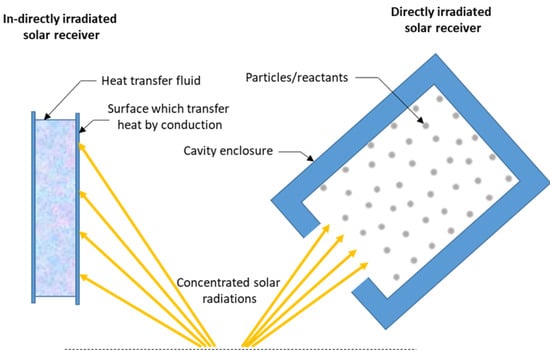
Figure 13.
The basic conception of indirectly and directly irradiated receivers.
The need of the refractory lining increases as the temperature approaches or exceeds 1000 °C [152]. Refractories used in high-temperature particle receivers must withstand high thermal shock due to cyclic heating and mechanical abrasion, along with the lower heat losses occurring during the transient operation. The proper selection of refractory material and its behavior under transient operating conditions will largely influence the thermal performance and life of a high-temperature receiver. The properties and quality of the refractory will also determine the extent of heat losses from a receiver cavity when a variable solar DNI is received at the aperture. Furthermore, the operation of a receiver with particles involves abrasion; thus, to avoid refractory failures and unplanned shutdowns, a multi-layer refractory is typically employed.
Refractory Materials
The most common materials used for the manufacture of refractories are oxides of aluminium (alumina), silicon (silica), and magnesium (magnesia):
- Alumina (Al2O3) refractories are composed of ≥50% alumina, and these are sensitive to thermal shock, requiring slow warm-up [153,154]. Furthermore, higher creep rates of alumina limit its use to temperatures below 1500 °C [155]. Alumina refractory bricks are mainly employed in cement and metallurgy kilns.
- Silica refractories are composed of >93% silicon oxide (SiO2). These can withstand high thermal and mechanical shocks [156]. An important property of silica brick is its ability to maintain hardness under high loads up to its melting point of ~1700 °C [157]. At a temperature of around 593 °C, silica bricks are nearly volume stable and virtually free from thermal spalling, while at temperatures below 593 °C, silica bricks are highly susceptible to thermal spalling. This is why the slow heating of silica refractories during start-up increases their functional lives [157]. Silica refractory bricks are used as refractories in iron and steel industries.
- Magnesite refractories are composed of ≥85% magnesium oxide (MgO) [158]. These have good thermal shock and excellent slag-corrosion resistance at elevated temperatures (around 1500 °C) [159], but MgO bricks are not capable of resisting sudden changes in temperature and show a tendency to spall under such conditions. Magnesite refractories are costlier than silica and used in the construction of those parts of a furnace that are required to withstand the corrosive action of basic slags.
- Fireclay refractories such as super duty firebricks with <50% Al2O3 are another type of refractory used for high-temperature applications [160]. Fireclay refractory bricks have good spalling resistance and maintain their true form when exposed to high temperatures [161]. They have a lower coefficient of thermal expansion relative to alumina [154,161,162,163]. Fireclay refractory bricks are cheaper in comparison to alumina, silica, and magnesia refractories. The fireclay refractories are used for the linings of blast and heat treatment furnaces.
The lightweight fiber refractories with lower thermal conductivities provide good insulation and lower the heat losses from a refractory-lined receiver to its surroundings. However, these fiber refractories cannot be used as the hot inside lining, which comes into direct contact with the particles and high-temperature environment, as they offer less resistance to mechanical and thermal stresses. Dense refractory materials with good resistance to mechanical abrasion and thermal shock are required on the inside of a receiver cavity. The insulating layer of refractory above the hot face lining can be made of a less dense material with lower thermal conductivity [164]. This is why most non-solar devices, such as rotary kilns, employ a multilayered cavity under extreme operating conditions, even though they mostly operate under steady-state conditions [153,165]. This is incompatible with the operation of a directly irradiated solar receiver, which needs to accommodate the solar transients during its operation [166]. Hence, there is a need for a more detailed assessment of how to optimize the performances of refractory-lined solar receivers under transient operating conditions.
6. Uncertainties Due to Steady-State Assumption
In addressing the challenges posed by the inherent variability in solar resources, researchers have explored diverse methodologies. One prominent approach involves integrating a capacity factor into a steady-state model. Typically, a constant capacity value is employed to forecast the overall performances of solar systems across the entire year. While this technique might be suitable for systems operating under lower-temperature conditions, it introduces substantial uncertainty when applied to high-temperature systems like particle receivers. This uncertainty is particularly amplified due to the directional dependence of solar resources on the sun’s position and intensity, which varies with both location and time. The total energy acquired using the receiver is contingent on DNI falling onto the solar field and the solar field’s efficiency in terms of reflecting radiation to the high-temperature particle receiver. Both factors are dynamic, relying on the time and location. To ensure accurate performance estimations for high-temperature particle receivers, it is imperative to consider solar resource variability when estimating solar field efficiency and DNI.
This section systematically evaluates the uncertainty involved in estimating the energy input to high-temperature particle receivers arising from steady-state assumptions. The energy absorbed via the receiver directly correlates with solar radiation incident upon its aperture, making the uncertainty in solar energy incidence synonymous with the uncertainty in the receiver’s energy absorption and overall performance. The evaluation employs direct normal irradiance data from Pinjarra, Australia, categorized into four seasons. Representative months from each season are selected to elucidate the impacts of solar resource variability throughout the year. Two scenarios are considered: one has real-time hourly solar irradiance data and the other assumes a constant DNI averaged over sunshine hours.
The results, as illustrated in Figure 14, highlight the substantial uncertainty introduced through the assumption of a steady-state operation. Observations from all four seasons reveal considerable uncertainty in predicting energy input for high-temperature particle receivers. Notably, the steady-state assumption leads to overestimations in the morning and late afternoon during December, March, and June, as well as underestimating energy gain in the middle of the day. The trend varies during September due to cloudy periods. Alarming uncertainties, ranging from 15 to 45%, are observed at solar noon for summer, autumn, winter, and spring, emphasizing the inadequacy of steady-state assumptions, even for a single site across the entire year.
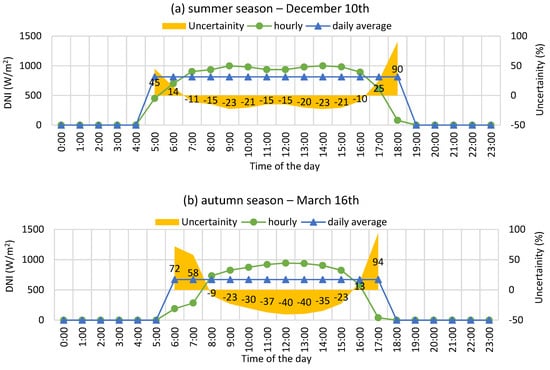
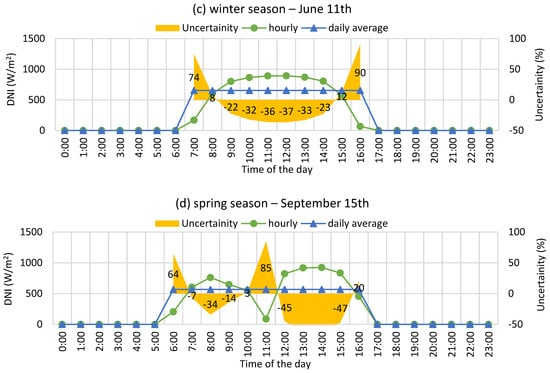
Figure 14.
Comparison of direct normal irradiance data in Pinjarra, Australia: impact of solar resource variability on a typical day during different seasons.
In conclusion, the reliance on steady-state assumptions for predicting the performances of high-temperature particle receivers introduces significant uncertainties, rendering them unsuitable for use in accurate yearly performance assessments. This underscores the imperative to analyze and design these receivers based on transient operation, incorporating real-time solar resource data specific to a site and time of year. Implementing a constant value to represent the overall yearly performance, accounting for solar resource variability, risks generating inaccurate predictions and design specifications.
7. Need of System-Level Analysis for Process Heat
The recent advances in CST technology, notably the advancements in high-temperature particle-laden receivers achieving temperatures of approximately 1000 °C, offer a promising avenue for exploring new markets and applications. In particular, high-temperature particle-laden receivers are being developed to achieve temperatures in the order of 1000 °C for advanced power cycles and solar thermochemical processes [17]. The integration of these solar central receiver systems has been widely reported in the literature, albeit only for the generation of electricity using steam and gas turbine cycles. However, there are limited studies of the integrated systems used to produce high-temperature heat, i.e., above 1000 °C, for heavy industrial applications, such as the production of alumina and hydrogen.
The narrative is enriched by several case studies illustrating the potential of integrated high-temperature receiver systems for use in electricity generation. Noteworthy examples include the analysis by Rovense et al. [34] of a 150 MW power plant with a multi-tower upward fluidized bed solar receiver, the study of a 20 MW power plant with a fluidized particle-in-tube receiver by Behar et al. [35], and the investigation of a dense particle suspension flow solar receiver by Reyes-Belmonte et al. [36]. These studies showcase diverse technological approaches, each with its unique thermal efficiencies, overall plant efficiencies, and solar-to-electric efficiency metrics. González-Portillo et al. [37] delve into the techno-economics of a CSP system incorporating a free-falling particle receiver, ground-based thermal storage bins, and a supercritical CO2 cycle, demonstrating a potential reduction in the levelized cost of electricity (LCOE). Similarly, Albrecht et al.’s [38] simulation of the annual energy production and LCOE estimation for commercial-scale CSP systems featuring a falling particle receiver, moving packed-bed heat exchanger, storage bin, particle lift, and recompression supercritical CO2 cycle underscores the economic viability of particle-based CSP technology. Buck et al. [39] reported that the multi-tower CSP system with a centrifugal particle receiver operating at 700–1000 °C adds further diversity to the technological landscape. Despite these advancements, a critical gap in knowledge exists regarding the industrial-level performance of these solar thermal systems. Specifically, there is a lack of comprehensive data addressing the reheating of returned warm air from a thermal storage system, accounting for transient losses over an entire year of operation at a potential plant site.
Although these solar thermal systems with central receiver technology have been proven to be suitable for driving high-temperature power cycles, there is a lack of available data regarding their industrial-level system performance in terms of their suitability to re-heat returned warm air from a thermal storage system, considering transient losses through a year of operation at a potential plant site.
In summary, recent innovations in concentrating solar thermal technology, particularly in the development of high-temperature particle-laden receivers reaching temperatures of around 1000 °C, have opened up new potential markets for consideration. While the existing literature extensively covers the integration of these solar central receiver systems for electricity generation through steam and gas turbine cycles, there is a noticeable lack of studies focused on producing high-temperature heat exceeding 1000 °C for heavy industrial applications, such as alumina and hydrogen production. Noteworthy examples of integrated high-temperature receiver systems used for electricity generation are presented above, showcasing varying capacities, efficiencies, and techno-economic analyses. Despite the demonstrated suitability of solar thermal systems for driving high-temperature power cycles, a critical limitation lies in the scarcity of available data concerning their industrial-level system performance, particularly regarding the re-heating of returned warm air from a thermal storage system, considering transient losses over a full year of operation at a potential plant site. Filling this knowledge gap would be pivotal for advancing the practical implementation of these innovative technologies in real-world industrial settings.
In light of this gap, future research endeavors should prioritize generating comprehensive data regarding the industrial-level performance of high-temperature particle-laden receivers. This includes addressing the intricacies of re-heating warm air from thermal storage systems and accounting for transient losses over prolonged operational periods. Such insights are pivotal for advancing the practical implementation of these innovative technologies within the complex and demanding context of heavy industrial applications. Closing this knowledge gap will not only enhance our understanding of these technologies but also facilitate their seamless integration into real-world industrial settings, ultimately contributing to the development of sustainable and efficient energy solutions.
8. A Comparative View on Techno-Economic Aspects
The comparative techno-economics between CST and photovoltaic (PV) systems involves a multifaceted analysis of various cost and performance factors. CST systems, characterized by their ability to concentrate sunlight to generate high temperatures, typically incur higher initial capital costs due to their need for complex components like mirrors or lenses. These systems are well suited to use in applications such as power generation and industrial processes but may have higher maintenance requirements due to having moving parts and tracking systems. In contrast, PV systems, known for their versatility in applications ranging from residential to commercial, have witnessed substantial cost reductions over time and generally have lower maintenance costs. The efficiency and land use considerations play pivotal roles, with CST systems excelling in concentrated solar power applications, while PV systems offer flexibility in various settings. Government incentives, technological advancements, and geographical factors further shape the economic landscape, influencing the overall cost competitiveness of CST and PV technologies. As the solar energy sector continues to evolve, the techno-economic study will play a key role in providing a vital foundation for informed decision-making in terms of adopting sustainable and cost-effective solar energy solutions.
Historically, the cost dynamics between CST and PV exhibit distinct trends. Operational and maintenance costs typically favor PV systems, given their simpler technology and fewer moving parts. Considerations of efficiency and land use are critical factors shaping the techno-economic landscape. CST systems excel in concentrated solar power applications but may necessitate more extensive land use. In contrast, PV systems offer deployment flexibility and can be integrated into various settings with different spatial constraints.
The impact of government incentives and policies is paramount. Subsidies, tax credits, and regulatory frameworks significantly influence the cost dynamics of both CST and PV systems, shaping their overall competitiveness in the market. Ongoing technological advancements and innovations also contribute to the dynamic nature of this study, with potential breakthroughs being capable of reshaping the cost and efficiency profiles of both technologies.
The effectiveness of CST and PV systems varies based on the specific location of the solar installation, underscoring the importance of a context-specific techno-economic evaluation. This further highlights the need for thorough and context-sensitive techno-economic studies for stakeholders pursuing sustainable and cost-effective solar energy solutions. This analysis, considering the multifaceted nature of CST and PV technologies, forms a robust foundation for strategic decision-making in the ever-evolving field of solar energy.
9. Summary and Concluding Remarks
This comprehensive review delves into the recent studies of high-temperature solar particle receivers, elucidating their pivotal role in the overarching endeavor of industrial decarbonization. The technologies under scrutiny have emerged as beacons of progress, offering efficient mechanisms to harness solar energy for high-temperature applications and, in turn, significantly advancing the cause of sustainable and environmentally responsible industrial practices. This review highlights the critical importance of accounting for solar resource variability, understanding the intricacies of refractory material properties, and considering the nuanced operational dynamics involved in the meticulous design and optimization of solar particle receivers.
In addition to the discussed advancements, it is crucial to consider persistent challenges in the design and operation of high-temperature particle-laden receivers. Given their design temperature surpasses the melting point of mild steel, necessitating a refractory lining with inherent brittleness and high thermal inertia, a fundamental departure from the transient response observed in tubular receivers is evident [167]. Although challenges during transient operation have been recognized in various contexts, comprehensive assessments, especially for refractory-lined high-temperature particle-laden receivers, are notably absent, emphasizing a critical research gap [82,83,168,169,170,171]. The higher thermal inertia of refractory linings compared to metal tubes further complicates the understanding of their behavior under unsteady conditions. Addressing this gap is imperative for identifying how these receivers respond to fluctuations in solar resource availability during transient operation.
Moreover, there is a noticeable gap regarding investigations into overnight heat loss for refractory-lined cavity receivers across diverse geometric parameters and operating conditions. The intricacies of receiver shutdown strategies and the optimal combination of insulation thickness and inner refractory thickness for enhanced thermal gains remain inadequately explored. This highlights the pressing need for further investigations into the thermal behavior of refractory-lined receivers. A nuanced understanding of the trade-offs between operating temperature, overnight temperature drop, and start-up time, as informed by extended time-series solar input data, is essential for advancing the efficiency and practical applicability of these receivers in the context of industrial decarbonization. Bridging these knowledge gaps will not only enrich our comprehension of high-temperature solar technologies but also contribute to the holistic integration of these systems into sustainable industrial practices.
As we traverse the landscape of renewable energy solutions, these advancements not only exemplify the transformative potential of high-temperature solar technologies in decarbonizing industries but also accentuate the necessity of sustained research and innovation in this dynamic field. The integration of high-temperature solar particle receivers into industrial processes holds the promise of not only reducing carbon emissions but also fundamentally reshaping production methods towards cleaner, more sustainable paradigms. This underscores a critical juncture in our collective pursuit of a low-carbon future, where the deployment of high-temperature solar particle receivers provides a beacon of hope, embodying the tangible contributions that science and technology can make toward a global transition to a more sustainable energy-based future.
Author Contributions
Conceptualization, M.M.R.; methodology, M.M.R.; software, M.M.R.; formal analysis, M.M.R.; investigation, M.M.R.; resources, M.M.R., S.R. and L.M.A.; data curation, M.M.R., S.R. and L.M.A.; writing—original draft preparation, M.M.R.; writing—review and editing, M.M.R., S.R. and L.M.A. All authors have read and agreed to the published version of the manuscript.
Funding
The authors would like to acknowledge the support of the Applied Research Center for Environ-ment and Marine Studies (ARCEMS), the King Fahd University of Petroleum and Minerals (KFUPM), Dhahran, Saudi Arabia.
Conflicts of Interest
The authors declare no conflict of interest.
References
- Lewis, N.; Nocera, D. Powering the planet: Chemical challenges in solar energy utilization. Proc. Natl. Acad. Sci. USA 2006, 103, 15729–15735. [Google Scholar] [CrossRef] [PubMed]
- Rafique, M.M.; Nathan, G.; Saw, W. Uncertainty in predicting the start-up time and losses for a high temperature particle receiver due to solar resource variability. In Energy Sustainability; American Society of Mechanical Engineers: New York, NY, USA, 2020; Volume 83631, p. V001T02A007. [Google Scholar] [CrossRef]
- Zhang, H.L.; Baeyens, J.; Degrève, J.; Cacères, G. Concentrated solar power plants: Review and design methodology. Renew. Sustain. Energy Rev. 2013, 22, 466–481. [Google Scholar] [CrossRef]
- Behar, O.; Khellaf, A.; Mohammedi, K. A review of studies on central receiver solar thermal power plants. Renew. Sustain. Energy Rev. 2013, 23, 12–39. [Google Scholar] [CrossRef]
- Pavlović, T.M.; Radonjić, I.S.; Milosavljević, D.D.; Pantić, L.S. A review of concentrating solar power plants in the world and their potential use in Serbia. Renew. Sustain. Energy Rev. 2012, 16, 3891–3902. [Google Scholar] [CrossRef]
- Steinfeld, A. Solar thermochemical production of hydrogen—A review. Sol. Energy 2005, 78, 603–615. [Google Scholar] [CrossRef]
- Quaschning, V. Technical and economical system comparison of photovoltaic and concentrating solar thermal power systems depending on annual global irradiation. Sol. Energy 2004, 77, 171–178. [Google Scholar] [CrossRef]
- Patil, V.R.; Kiener, F.; Grylka, A.; Steinfeld, A. Experimental testing of a solar air cavity-receiver with reticulated porous ceramic absorbers for thermal processing at above 1000 °C. Sol. Energy 2021, 214, 72–85. [Google Scholar] [CrossRef]
- Davis, D.; Müller, F.; Saw, W.L.; Steinfeld, A.; Nathan, G.J. Solar-driven alumina calcination for CO2 mitigation and improved product quality. Green Chem. 2017, 19, 2992–3005. [Google Scholar] [CrossRef]
- Ho, C.K.; Albrecht, K.J.; Yue, L.; Mills, B.; Sment, J.; Christian, J.; Carlson, M. Overview and design basis for the Gen 3 Particle Pilot Plant (G3P3). AIP Conf. Proc. 2020, 2303, 030020. [Google Scholar] [CrossRef]
- Romero, M.; González-Aguilar, J. 7—Next generation of liquid metal and other high-performance receiver designs for concentrating solar thermal (CST) central tower systems. In Advances in Concentrating Solar Thermal Research and Technology; Blanco, M.J., Santigosa, L.R., Eds.; Woodhead Publishing: Sawston, UK, 2017; pp. 129–154. [Google Scholar] [CrossRef]
- Bradshaw, R.W.; Cordaro, J.G.; Siegel, N.P. Molten Nitrate Salt Development for Thermal Energy Storage in Parabolic Trough Solar Power Systems. In Proceedings of the ASME 2009 3rd International Conference on Energy Sustainability Collocated with the Heat Transfer and InterPACK09 Conferences, San Francisco, CA, USA, 19–23 July 2009; pp. 615–624. [Google Scholar]
- Pedraza, J.; Zimmermann, A.; Tobon, J.; Schomäcker, R.; Rojas, N. On the road to net zero-emission cement: Integrated assessment of mineral carbonation of cement kiln dust. Chem. Eng. J. 2021, 408, 127346. [Google Scholar] [CrossRef]
- Wang, P.; Ryberg, M.; Yang, Y.; Feng, K.; Kara, S.; Hauschild, M.; Chen, W.-Q. Efficiency stagnation in global steel production urges joint supply- and demand-side mitigation efforts. Nat. Commun. 2021, 12, 2066. [Google Scholar] [CrossRef]
- Rafique, M.M.; Bahaidarah, H.M.S. Impacts of solar intensity on the techno-economic feasibility of particle receiver technology. J. Clean. Prod. 2021, 285, 124908. [Google Scholar] [CrossRef]
- Rafique, M.M.; Nathan, G.; Saw, W. Modelled annual thermal performance of a 50 MWth refractory-lined particle-laden solar receiver operating above 1000 °C. Renew. Energy 2022, 197, 1081–1093. [Google Scholar] [CrossRef]
- Mills, B.H.; Ho, C.K.; Schroeder, N.R.; Shaeffer, R.; Laubscher, H.F.; Albrecht, K.J. Design Evaluation of a Next-Generation High-Temperature Particle Receiver for Concentrating Solar Thermal Applications. Energies 2022, 15, 1657. [Google Scholar] [CrossRef]
- Christian, J.; Ho, C. System Design of a 1 MW North-facing, Solid Particle Receiver. Energy Procedia 2015, 69, 340–349. [Google Scholar] [CrossRef][Green Version]
- Kolb, G.J.; Diver, R.B.; Siegel, N. Central-Station Solar Hydrogen Power Plant. J. Sol. Energy Eng. 2006, 129, 179–183. [Google Scholar] [CrossRef]
- Siegel, N.P.; Ho, C.K.; Khalsa, S.S.; Kolb, G.J. Development and Evaluation of a Prototype Solid Particle Receiver: On-Sun Testing and Model Validation. J. Sol. Energy Eng. 2010, 132, 021008. [Google Scholar] [CrossRef]
- Röger, M.; Amsbeck, L.; Gobereit, B.; Buck, R. Face-Down Solid Particle Receiver Using Recirculation. J. Sol. Energy Eng. 2011, 133, 031009. [Google Scholar] [CrossRef]
- Tan, T.; Chen, Y.; Chen, Z.; Siegel, N.; Kolb, G.J. Wind effect on the performance of solid particle solar receivers with and without the protection of an aerowindow. Sol. Energy 2009, 83, 1815–1827. [Google Scholar] [CrossRef]
- Wu, W.; Uhlig, R.; Buck, R.; Pitz-Paal, R. Numerical Simulation of a Centrifugal Particle Receiver for High-Temperature Concentrating Solar Applications. Numer. Heat Transf. Part A Appl. 2015, 68, 133–149. [Google Scholar] [CrossRef]
- Wu, W.; Trebing, D.; Amsbeck, L.; Buck, R.; Pitz-Paal, R. Prototype Testing of a Centrifugal Particle Receiver for High-Temperature Concentrating Solar Applications. J. Sol. Energy Eng. 2015, 137, 041011. [Google Scholar] [CrossRef]
- Wu, W.; Amsbeck, L.; Buck, R.; Uhlig, R.; Ritz-Paal, R. Proof of Concept Test of a Centrifugal Particle Receiver. Energy Procedia 2014, 49, 560–568. [Google Scholar] [CrossRef]
- Wu, W.; Amsbeck, L.; Buck, R.; Waibel, N.; Langner, P.; Pitz-Paal, R. On the influence of rotation on thermal convection in a rotating cavity for solar receiver applications. Appl. Therm. Eng. 2014, 70, 694–704. [Google Scholar] [CrossRef]
- Flamant, G.; Gauthier, D.; Benoit, H.; Sans, J.-L.; Garcia, R.; Boissière, B.; Ansart, R.; Hemati, M. Dense suspension of solid particles as a new heat transfer fluid for concentrated solar thermal plants: On-sun proof of concept. Chem. Eng. Sci. 2013, 102, 567–576. [Google Scholar] [CrossRef]
- Falcone, P.K.; Noring, J.E.; Hruby, J.M. Assessment of a Solid Particle Receiver for a High Temperature Solar Central Receiver System; Sandia National Labs.: Livermore, CA, USA, 1985; p. 93. [Google Scholar]
- Chinnici, A.; Arjomandi, M.; Tian, Z.F.; Lu, Z.; Nathan, G.J. A Novel Solar Expanding-Vortex Particle Reactor: Influence of Vortex Structure on Particle Residence Times and Trajectories. Sol. Energy 2015, 122, 58–75. [Google Scholar] [CrossRef]
- Ortiz, O.A.; Suárez, G.I.; Nelson, A. Dynamic simulation of a pilot rotary kiln for charcoal activation. Comput. Chem. Eng. 2005, 29, 1837–1848. [Google Scholar] [CrossRef]
- Abanades, S.; Charvin, P.; Flamant, G. Design and simulation of a solar chemical reactor for the thermal reduction of metal oxides: Case study of zinc oxide dissociation. Chem. Eng. Sci. 2007, 62, 6323–6333. [Google Scholar] [CrossRef]
- Soo Too, Y.C.; García, J.; Padilla, R.V.; Kim, J.-S.; Sanjuan, M. A transient optical-thermal model with dynamic matrix controller for solar central receivers. Appl. Therm. Eng. 2019, 154, 686–698. [Google Scholar] [CrossRef]
- Rafique, M.M.; Nathan, G.; Saw, W. A mathematical model to assess the influence of transients on a refractory-lined solar receiver. Renew. Energy 2020, 167, 217–235. [Google Scholar] [CrossRef]
- Rovense, F.; Reyes-Belmonte, M.Á.; Romero, M.; González-Aguilar, J. Thermo-economic analysis of a particle-based multi-tower solar power plant using unfired combined cycle for evening peak power generation. Energy 2022, 240, 122798. [Google Scholar] [CrossRef]
- Behar, O.; Grange, B.; Flamant, G. Design and performance of a modular combined cycle solar power plant using the fluidized particle solar receiver technology. Energy Convers. Manag. 2020, 220, 113108. [Google Scholar] [CrossRef]
- Reyes-Belmonte, M.A.; Sebastián, A.; Spelling, J.; Romero, M.; González-Aguilar, J. Annual performance of subcritical Rankine cycle coupled to an innovative particle receiver solar power plant. Renew. Energy 2019, 130, 786–795. [Google Scholar] [CrossRef]
- González-Portillo, L.F.; Albrecht, K.; Ho, C.K. Techno-Economic Optimization of CSP Plants with Free-Falling Particle Receivers. Entropy 2021, 23, 76. [Google Scholar] [CrossRef] [PubMed]
- Albrecht, K.J.; Bauer, M.L.; Ho, C.K. Parametric Analysis of Particle CSP System Performance and Cost to Intrinsic Particle Properties and Operating Conditions. In Proceedings of the ASME 2019 13th International Conference on Energy Sustainability Collocated with the ASME 2019 Heat Transfer Summer Conference, Bellevue, WA, USA, 14–17 July 2019. [Google Scholar]
- Buck, R.; Giuliano, S. Impact of Solar Tower Design Parameters on xCO2-based Solar Tower Plants. In Proceedings of the 2nd European sCO2 Conference, Essen, Germany, 30–31 August 2018. [Google Scholar]
- Merchán, R.P.; Santos, M.J.; Medina, A.; Calvo Hernández, A. High temperature central tower plants for concentrated solar power: 2021 overview. Renew. Sustain. Energy Rev. 2022, 155, 111828. [Google Scholar] [CrossRef]
- IEA. World Energy Outlook. Available online: www.worldenergyoutlook.org (accessed on 15 March 2020).
- IEA. Global Energy Review: CO2 Emissions in 2021. Available online: https://www.iea.org/reports/global-energy-review-co2-emissions-in-2021-2 (accessed on 28 October 2023).
- IEA. International Energy Agency. Available online: https://www.iea.org (accessed on 15 March 2020).
- Hayes, D. Asian renewables: South East Asia regional overview. Refocus 2004, 5, 48. [Google Scholar] [CrossRef]
- He, Y.-L.; Qiu, Y.; Wang, K.; Yuan, F.; Wang, W.-Q.; Li, M.-J.; Guo, J.-Q. Perspective of concentrating solar power. Energy 2020, 198, 117373. [Google Scholar] [CrossRef]
- GlobalData. Available online: https://www.globaldata.com/ (accessed on 28 October 2023).
- Achkari, O.; El Fadar, A. Latest developments on TES and CSP technologies—Energy and environmental issues, applications and research trends. Appl. Therm. Eng. 2020, 167, 114806. [Google Scholar] [CrossRef]
- Rafique, M.M.; Nathan, G.; Saw, W. Thermal response of multilayered refractory-lined solar receivers to transient operation. Sol. Energy 2022, 243, 70–80. [Google Scholar] [CrossRef]
- Tan, T.; Chen, Y. Review of study on solid particle solar receivers. Renew. Sustain. Energy Rev. 2010, 14, 265–276. [Google Scholar] [CrossRef]
- Ho, C.K. Advances in central receivers for concentrating solar applications. Sol. Energy 2017, 152, 38–56. [Google Scholar] [CrossRef]
- Islam, M.T.; Huda, N.; Abdullah, A.B.; Saidur, R. A comprehensive review of state-of-the-art concentrating solar power (CSP) technologies: Current status and research trends. Renew. Sustain. Energy Rev. 2018, 91, 987–1018. [Google Scholar] [CrossRef]
- IEA. CO2 Emissions from Energy Combustion and Industrial Processes, 1900–2021, IEA, Paris. Available online: https://www.iea.org/data-and-statistics/charts/co2-emissions-from-energy-combustion-and-industrial-processes-1900-2021 (accessed on 28 October 2023).
- Greenpeace International. Available online: https://energypedia.info/wiki/Greenpeace_International_Concentrating_Solar_Power_Global_Outlook (accessed on 30 March 2020).
- Bradshaw, R.W.; Carling, R.W. A Review of the Chemical and Physical Properties of Molten Alkali Nitrate Salts and Their Effect on Materials Used for Solar Central Receivers; The Electrochemical Society: Pennington, NJ, USA, 1987. [Google Scholar]
- Reddy, R.G. Novel Molten Salts Thermal Energy Storage for Concentrating Solar Power Generation; Univ. of Alabama: Tuscaloosa, AL, USA, 2013. [Google Scholar]
- Fernández, A.G.; Galleguillos, H.; Fuentealba, E.; Pérez, F.J. Thermal characterization of HITEC molten salt for energy storage in solar linear concentrated technology. J. Therm. Anal. Calorim. 2015, 122, 3–9. [Google Scholar] [CrossRef]
- Benammar, S. A review study on the modeling and simulation of solar tower power plants. J. Sol. Energy Res 2020, 7, 100–121. [Google Scholar] [CrossRef]
- Freeman, E.S. The Kinetics of the Thermal Decomposition of Sodium Nitrate and of the Reaction between Sodium Nitrite and Oxygen. J. Phys. Chem. 1956, 60, 1487–1493. [Google Scholar] [CrossRef]
- Luque, S.; Menéndez, G.; Roccabruna, M.; González-Aguilar, J.; Crema, L.; Romero, M. Exploiting volumetric effects in novel additively manufactured open solar receivers. Sol. Energy 2018, 174, 342–351. [Google Scholar] [CrossRef]
- Hoffschmidt, B.; Pitz-Paal, R.; Bohmer, M.; Fend, T.; Rietbrock, P. 200 kW{sub th} open volumetric air receiver (HiTRec) of DLR reached 1000 deg C average outlet temperature at PSA. J. Phys. 1999, 4, 551–556. [Google Scholar]
- Buck, R.; Bräuning, T.; Denk, T.; Pfänder, M.; Schwarzbözl, P.; Tellez, F. Solar-Hybrid Gas Turbine-based Power Tower Systems (REFOS)*. J. Sol. Energy Eng. 2001, 124, 2–9. [Google Scholar] [CrossRef]
- Pritzkow, W.E.C. Pressure loaded volumetric ceramic receiver. Sol. Energy Mater. 1991, 24, 498–507. [Google Scholar] [CrossRef]
- Stadler, H.; Maldonado, D.; Offergeld, M.; Schwarzbözl, P.; Trautner, J. CFD model for the performance estimation of open volumetric receivers and comparison with experimental data. Sol. Energy 2019, 177, 634–641. [Google Scholar] [CrossRef]
- Ho, C.K.; Iverson, B.D. Review of high-temperature central receiver designs for concentrating solar power. Renew. Sustain. Energy Rev. 2014, 29, 835–846. [Google Scholar] [CrossRef]
- Ávila-Marín, A.L. Volumetric receivers in Solar Thermal Power Plants with Central Receiver System technology: A review. Sol. Energy 2011, 85, 891–910. [Google Scholar] [CrossRef]
- Long, S.; Lau, T.C.W.; Chinnici, A.; Nathan, G.J. The flow-field within a vortex-based solar cavity receiver with an open aperture. Exp. Therm. Fluid Sci. 2021, 123, 110314. [Google Scholar] [CrossRef]
- Davis, D.; Jafarian, M.; Chinnici, A.; Saw, W.L.; Nathan, G.J. Thermal performance of vortex-based solar particle receivers for sensible heating. Sol. Energy 2019, 177, 163–177. [Google Scholar] [CrossRef]
- Karni, J.; Kribus, A.; Ostraich, B.; Kochavi, E. A High-Pressure Window for Volumetric Solar Receivers. J. Sol. Energy Eng. 1998, 120, 101–107. [Google Scholar] [CrossRef]
- Chavez, J.M.; Chaza, C. Testing of a porous ceramic absorber for a volumetric air receiver. Sol. Energy Mater. 1991, 24, 172–181. [Google Scholar] [CrossRef]
- Romero, M.; González-Aguilar, J. Solar thermal CSP technology. Wiley Interdiscip. Rev. Energy Environ. 2014, 3, 42–59. [Google Scholar] [CrossRef]
- Ho, C.K.; Christian, J.; Yellowhair, J.; Jeter, S.; Golob, M.; Nguyen, C.; Repole, K.; Abdel-Khalik, S.; Siegel, N.; Al-Ansary, H.; et al. Highlights of the high-temperature falling particle receiver project: 2012–2016. AIP Conf. Proc. 2017, 1850, 030027. [Google Scholar] [CrossRef]
- Zanganeh, G.; Pedretti, A.; Zavattoni, S.; Barbato, M.; Steinfeld, A. Packed-bed thermal storage for concentrated solar power—Pilot-scale demonstration and industrial-scale design. Sol. Energy 2012, 86, 3084–3098. [Google Scholar] [CrossRef]
- Ma, Z.; Glatzmaier, G.C.; Mehos, M. Development of Solid Particle Thermal Energy Storage for Concentrating Solar Power Plants that Use Fluidized Bed Technology. Energy Procedia 2014, 49, 898–907. [Google Scholar] [CrossRef]
- Martin, J.; Vitko, J., Jr. ASCUAS: A Solar Central Receiver Utilizing a Solid Thermal Carrier; Sandia National Labs.: Livermore, CA, USA, 1982. [Google Scholar]
- Siegel, N.; Kolb, G. Design and On-Sun Testing of a Solid Particle Receiver Prototype. In Proceedings of the ASME 2008 2nd International Conference on Energy Sustainability Collocated with the Heat Transfer, Fluids Engineering, and 3rd Energy Nanotechnology Conferences, Jacksonville, FL, USA, 10–14 August 2008; pp. 329–334. [Google Scholar]
- Ho, C.; Christian, J.; Gill, D.; Moya, A.; Jeter, S.; Abdel-Khalik, S.; Sadowski, D.; Siegel, N.; Al-Ansary, H.; Amsbeck, L.; et al. Technology Advancements for Next Generation Falling Particle Receivers. Energy Procedia 2014, 49, 398–407. [Google Scholar] [CrossRef]
- Christian, J.; Ho, C. Alternative Designs of a High Efficiency, North-facing, Solid Particle Receiver. Energy Procedia 2014, 49, 314–323. [Google Scholar] [CrossRef]
- Hruby, J.M.; Steele, B.R. A solid particle central receiver for solar energy. Chem. Eng. Prog. 1986, 82, 2. [Google Scholar]
- Kim, K.; Moujaes, S.F.; Kolb, G.J. Experimental and simulation study on wind affecting particle flow in a solar receiver. Sol. Energy 2010, 84, 263–270. [Google Scholar] [CrossRef]
- Spelling, J.; Gallo, A.; Romero, M.; González-Aguilar, J. A High-efficiency Solar Thermal Power Plant using a Dense Particle Suspension as the Heat Transfer Fluid. Energy Procedia 2015, 69, 1160–1170. [Google Scholar] [CrossRef]
- Ortega, J.I.; Burgaleta, J.I.; Téllez, F.M. Central Receiver System Solar Power Plant Using Molten Salt as Heat Transfer Fluid. J. Sol. Energy Eng. 2008, 130, 024501. [Google Scholar] [CrossRef]
- Xu, L.; Stein, W.; Kim, J.-S.; Too, Y.C.S.; Guo, M.; Wang, Z. Transient numerical model for the thermal performance of the solar receiver. Appl. Therm. Eng. 2018, 141, 1035–1047. [Google Scholar] [CrossRef]
- Samanes, J.; Garcia-Barberena, J. A model for the transient performance simulation of solar cavity receivers. Sol. Energy 2014, 110, 789–806. [Google Scholar] [CrossRef]
- Ho, C.K. 6—A new generation of solid particle and other high-performance receiver designs for concentrating solar thermal (CST) central tower systems. In Advances in Concentrating Solar Thermal Research and Technology; Blanco, M.J., Santigosa, L.R., Eds.; Woodhead Publishing: Sawston, UK, 2017; pp. 107–128. [Google Scholar] [CrossRef]
- Bertocchi, R.; Karni, J.; Kribus, A. Experimental evaluation of a non-isothermal high temperature solar particle receiver. Energy 2004, 29, 687–700. [Google Scholar] [CrossRef]
- Perez Lopez, I.; Benoit, H.; Gauthier, D.; Sans, J.L.; Guillot, E.; Mazza, G.; Flamant, G. On-sun operation of a 150kWth pilot solar receiver using dense particle suspension as heat transfer fluid. Sol. Energy 2016, 137, 463–476. [Google Scholar] [CrossRef]
- Ho, C.K.; Christian, J.M.; Yellowhair, J.; Armijo, K.; Kolb, W.J.; Jeter, S.; Golob, M.; Nguyen, C. Performance Evaluation of a High-Temperature Falling Particle Receiver. In Proceedings of the ASME 2016 10th International Conference on Energy Sustainability Collocated with the ASME 2016 Power Conference and the ASME 2016 14th International Conference on Fuel Cell Science, Engineering and Technology, Charlotte, NC, USA, 26–30 June 2016. [Google Scholar]
- Meier, A. A predictive CFD model for a falling particle receiver/reactor exposed to concentrated sunlight. Chem. Eng. Sci. 1999, 54, 2899–2905. [Google Scholar] [CrossRef]
- Hruby, J.M. Technical Feasibility Study of a Solid Particle Solar Central Receiver for High Temperature Applications; Sandia National Labs.: Livermore, CA, USA, 1986. [Google Scholar]
- Ebert, M.; Amsbeck, L.; Rheinländer, J.; Schlögl-Knothe, B.; Schmitz, S.; Sibum, M.; Uhlig, R.; Buck, R. Operational experience of a centrifugal particle receiver prototype. AIP Conf. Proc. 2019, 2126, 030018. [Google Scholar] [CrossRef]
- Flamant, G.; Gauthier, D.; Benoit, H.; Sans, J.L.; Boissière, B.; Ansart, R.; Hemati, M. A New Heat Transfer Fluid for Concentrating Solar Systems: Particle Flow in Tubes. Energy Procedia 2014, 49, 617–626. [Google Scholar] [CrossRef]
- Martinek, J.; Ma, Z. Granular Flow and Heat-Transfer Study in a Near-Blackbody Enclosed Particle Receiver. J. Sol. Energy Eng. 2015, 137, 051008. [Google Scholar] [CrossRef]
- Gallo, A.; Spelling, J.; Romero, M.; González-Aguilar, J. Preliminary Design and Performance Analysis of a Multi-megawatt Scale Dense Particle Suspension Receiver. Energy Procedia 2015, 69, 388–397. [Google Scholar] [CrossRef]
- Gobereit, B.; Amsbeck, L.; Buck, R.; Pitz-Paal, R.; Röger, M.; Müller-Steinhagen, H. Assessment of a falling solid particle receiver with numerical simulation. Sol. Energy 2015, 115, 505–517. [Google Scholar] [CrossRef][Green Version]
- Ho, C.K.; Christian, J.M.; Yellowhair, J.E.; Armijo, K.; Kolb, W.J.; Jeter, S.; Golob, M.; Nguyen, C. On-Sun Performance Evaluation of Alternative High-Temperature Falling Particle Receiver Designs. J. Sol. Energy Eng. 2018, 141, 011009. [Google Scholar] [CrossRef]
- Al-Ansary, H.; El-Leathy, A.; Jeter, S.; Djajadiwinata, E.; Alaqel, S.; Golob, M.; Nguyen, C.; Saad, R.; Shafiq, T.; Danish, S.; et al. On-sun experiments on a particle heating receiver with red sand as the working medium. In Proceedings of the American Institute of Physics Conference Series, Santiago, Chile, 26–29 September 2017. [Google Scholar]
- Lee, T.; Lim, S.; Shin, S.; Sadowski, D.L.; Abdel-Khalik, S.I.; Jeter, S.M.; Al-Ansary, H. Numerical simulation of particulate flow in interconnected porous media for central particle-heating receiver applications. Sol. Energy 2015, 113, 14–24. [Google Scholar] [CrossRef]
- Xie, X.; Xiao, G.; Ni, M.; Yan, J.; Dong, H.; Cen, K. Optical and thermal performance of a novel solar particle receiver. AIP Conf. Proc. 2019, 2126, 030065. [Google Scholar] [CrossRef]
- Xiao, G.; Guo, K.; Ni, M.; Luo, Z.; Cen, K. Optical and thermal performance of a high-temperature spiral solar particle receiver. Sol. Energy 2014, 109, 200–213. [Google Scholar] [CrossRef]
- Ho, C.K. A review of high-temperature particle receivers for concentrating solar power. Appl. Therm. Eng. 2016, 109, 958–969. [Google Scholar] [CrossRef]
- Hirsch, D.; Steinfeld, A. Solar hydrogen production by thermal decomposition of natural gas using a vortex-flow reactor. Int. J. Hydrog. Energy 2004, 29, 47–55. [Google Scholar] [CrossRef]
- Z’Graggen, A.; Haueter, P.; Trommer, D.; Romero, M.; de Jesus, J.C.; Steinfeld, A. Hydrogen production by steam-gasification of petroleum coke using concentrated solar power—II Reactor design, testing, and modeling. Int. J. Hydrog. Energy 2006, 31, 797–811. [Google Scholar] [CrossRef]
- Müller, F.; Poživil, P.; van Eyk, P.J.; Villarrazo, A.; Haueter, P.; Wieckert, C.; Nathan, G.J.; Steinfeld, A. A pressurized high-flux solar reactor for the efficient thermochemical gasification of carbonaceous feedstock. Fuel 2017, 193, 432–443. [Google Scholar] [CrossRef]
- Steinfeld, A.; Imhof, A.; Mischler, D. Experimental Investigation of an Atmospheric-Open Cyclone Solar Reactor for Solid-Gas Thermochemical Reactions. J. Sol. Energy Eng. 1992, 114, 171–174. [Google Scholar] [CrossRef]
- Z’Graggen, A.; Haueter, P.; Maag, G.; Romero, M.; Steinfeld, A. Hydrogen production by steam-gasification of carbonaceous materials using concentrated solar energy—IV. Reactor experimentation with vacuum residue. Int. J. Hydrog. Energy 2008, 33, 679–684. [Google Scholar] [CrossRef]
- Z’Graggen, A.; Haueter, P.; Maag, G.; Vidal, A.; Romero, M.; Steinfeld, A. Hydrogen production by steam-gasification of petroleum coke using concentrated solar power—III. Reactor experimentation with slurry feeding. Int. J. Hydrog. Energy 2007, 32, 992–996. [Google Scholar] [CrossRef]
- Xiao, G.; Guo, K.; Luo, Z.; Ni, M.; Zhang, Y.; Wang, C. Simulation and experimental study on a spiral solid particle solar receiver. Appl. Energy 2014, 113, 178–188. [Google Scholar] [CrossRef]
- Ozalp, N.; Chien, M.-H.; Morrison, G. Computational Fluid Dynamics and Particle Image Velocimetry Characterization of a Solar Cyclone Reactor. J. Sol. Energy Eng. 2013, 135, 031003. [Google Scholar] [CrossRef]
- Ozalp, N.; JayaKrishna, D. CFD analysis on the influence of helical carving in a vortex flow solar reactor. Int. J. Hydrog. Energy 2010, 35, 6248–6260. [Google Scholar] [CrossRef]
- Ozalp, N.; Kanjirakat, A. A CFD study on the effect of carbon particle seeding for the improvement of solar reactor performance. In Proceedings of the ASME 2010 4th International Conference on Energy Sustainability, Phoenix, AZ, USA, 17–22 May 2010; pp. 143–152. [Google Scholar]
- Dai, S.; Chang, Z.; Chang, C.; Akhatov, J.S.; Li, X. Numerical study on the directly-irradiated vortex reactor for solar CO2 coal gasification. Sol. Energy 2019, 188, 573–585. [Google Scholar] [CrossRef]
- Miller, F.J.; Koenigsdorff, R.W. Thermal Modeling of a Small-Particle Solar Central Receiver. J. Sol. Energy Eng. 2000, 122, 23–29. [Google Scholar] [CrossRef]
- Oles, A.S. Modeling of Falling-Particle Solar Receivers for Hydrogen Production and Thermochemical Energy Storage. Ph.D. Thesis, University of Maryland, College Park, MD, USA, 2014. [Google Scholar]
- Jiang, K.; Du, X.; Kong, Y.; Xu, C.; Ju, X. A comprehensive review on solid particle receivers of concentrated solar power. Renew. Sustain. Energy Rev. 2019, 116, 109463. [Google Scholar] [CrossRef]
- Chinnici, A.; Arjomandi, M.; Tian, Z.F.; Nathan, G.J. A Novel Solar Expanding-Vortex Particle Reactor: Experimental and Numerical Investigation of the Iso-thermal Flow Field and Particle Deposition. Sol. Energy 2016, 133, 451–464. [Google Scholar] [CrossRef]
- Chinnici, A.; Xue, Y.; Lau, T.C.W.; Arjomandi, M.; Nathan, G.J. Experimental and numerical investigation of the flow characteristics within a Solar Expanding-Vortex Particle Receiver-Reactor. Sol. Energy 2017, 141, 25–37. [Google Scholar] [CrossRef]
- Hruby, J.; Steele, B.; Burolla, V. Solid Particle Receiver Experiments: Radiant Heat Test; Sandia National Lab.(SNL-CA): Livermore, CA, USA, 1984. [Google Scholar]
- Evans, G.; Houf, W.; Greif, R.; Crowe, C. Gas-Particle Flow Within a High Temperature Solar Cavity Receiver Including Radiation Heat Transfer. J. Sol. Energy Eng. 1987, 109, 134–142. [Google Scholar] [CrossRef]
- Chen, H.; Chen, Y.; Hsieh, H.-T.; Siegel, N. Computational Fluid Dynamics Modeling of Gas-Particle Flow Within a Solid-Particle Solar Receiver. J. Sol. Energy Eng. 2006, 129, 160–170. [Google Scholar] [CrossRef]
- Siegel, N.; Kolb, G.; Kim, K.; Rangaswamy, V.; Moujaes, S. Solid Particle Receiver Flow Characerization Studies. In Proceedings of the ASME 2007 Energy Sustainability Conference, Long Beach, CA, USA, 27–30 July 2007; pp. 877–883. [Google Scholar]
- Khalsa, S.S.S.; Ho, C.K. Radiation Boundary Conditions for Computational Fluid Dynamics Models of High-Temperature Cavity Receivers. J. Sol. Energy Eng. 2011, 133, 031020. [Google Scholar] [CrossRef]
- Ho, C.K.; Christian, J.M. Evaluation of Air Recirculation for Falling Particle Receivers. In Proceedings of the ASME 2013 7th International Conference on Energy Sustainability Collocated with the ASME 2013 Heat Transfer Summer Conference and the ASME 2013 11th International Conference on Fuel Cell Science, Engineering and Technology, Minneapolis, MN, USA, 14–19 July 2013. [Google Scholar]
- Ho, C.K.; Christian, J.M.; Moya, A.C.; Taylor, J.; Ray, D.; Kelton, J. Experimental and numerical studies of air curtains for falling particle receivers. In Energy Sustainability; American Society of Mechanical Engineers: New York, NY, USA, 2014. [Google Scholar]
- Siegel, N.; Gross, M.; Ho, C.; Phan, T.; Yuan, J. Physical Properties of Solid Particle Thermal Energy Storage Media for Concentrating Solar Power Applications. Energy Procedia 2014, 49, 1015–1023. [Google Scholar] [CrossRef]
- Shimizu, T. Heat Transfer to Solid Particles in a Stirred Bed; HM Stationery Office: Richmond, UK, 1969. [Google Scholar]
- Kumar, A.; Kim, J.-S.; Lipiński, W. Radiation Characteristics of a Particle Curtain in a Free-Falling Particle Solar Receiver. In Proceedings of the ASME 2017 Heat Transfer Summer Conference, Bellevue, WA, USA, 9–12 July 2017. [Google Scholar]
- Ho, C.K.; Christian, J.M.; Romano, D.; Yellowhair, J.; Siegel, N.; Savoldi, L.; Zanino, R. Characterization of Particle Flow in a Free-Falling Solar Particle Receiver. J. Sol. Energy Eng. 2016, 139, 021011. [Google Scholar] [CrossRef]
- Maag, G.; Falter, C.; Steinfeld, A. Temperature of a Quartz/Sapphire Window in a Solar Cavity-Receiver. J. Sol. Energy Eng. 2010, 133, 014501. [Google Scholar] [CrossRef]
- Yong, S.; Fu-Qiang, W.; Xin-Lin, X.; He-Ping, T.; Ying-Chun, L. Radiative properties of a solar cavity receiver/reactor with quartz window. Int. J. Hydrog. Energy 2011, 36, 12148–12158. [Google Scholar] [CrossRef]
- Khalsa, S.S.S.; Christian, J.M.; Kolb, G.J.; Ro¨ger, M.; Amsbeck, L.; Ho, C.K.; Siegel, N.P.; Moya, A.C. CFD Simulation and Performance Analysis of Alternative Designs for High-Temperature Solid Particle Receivers. In Proceedings of the ASME 2011 5th International Conference on Energy Sustainability, Washington, DC, USA, 7–10 August 2011; pp. 687–693. [Google Scholar]
- Chen, H.; Chen, Y.; Hsieh, H.-T.; Kolb, G.; Siegel, N. Numerical Investigation on Optimal Design of Solid Particle Solar Receiver. In Proceedings of the ASME 2007 Energy Sustainability Conference, Long Beach, CA, USA, 27–30 July 2007; pp. 971–979. [Google Scholar]
- Flamant, G. Theoretical and experimental study of radiant heat transfer in a solar fluidized-bed receiver. AIChE J. 1982, 28, 529–535. [Google Scholar] [CrossRef]
- Gallo, A.; Alonso, E.; Pérez-Rábago, C.; Fuentealba, E.; Roldán, M.I. A lab-scale rotary kiln for thermal treatment of particulate materials under high concentrated solar radiation: Experimental assessment and transient numerical modeling. Sol. Energy 2019, 188, 1013–1030. [Google Scholar] [CrossRef]
- Chinnici, A.; Davis, D.; Lau, T.C.W.; Ang, D.; Troiano, M.; Saw, W.L.; Tian, Z.F.; Solimene, R.; Salatino, P.; Nathan, G.J. Measured global thermal performance of a directly irradiated suspension-flow solar particle receiver with an open aperture. Sol. Energy 2022, 231, 185–193. [Google Scholar] [CrossRef]
- CET. Available online: https://www.adelaide.edu.au/cet/technologies/solar-expanding-vortex-particle-receiver-reactor-sevr. (accessed on 1 April 2020).
- Ho, C.K.; Christian, J.M.; Yellowhair, J.; Siegel, N.; Jeter, S.; Golob, M.; Abdel-Khalik, S.I.; Nguyen, C.; Al-Ansary, H. On-sun testing of an advanced falling particle receiver system. AIP Conf. Proc. 2016, 1734, 030022. [Google Scholar] [CrossRef]
- Knott, R.C.; Sadowski, D.L.; Jeter, S.M.; Abdel-Khalik, S.I.; Al-Ansary, H.A.; El-Leathy, A. High Temperature Durability of Solid Particles for Use in Particle Heating Concentrator Solar Power Systems. In Proceedings of the ASME 2014 8th International Conference on Energy Sustainability Collocated with the ASME 2014 12th International Conference on Fuel Cell Science, Engineering and Technology, Boston, MA, USA, 30 June–2 July 2014. [Google Scholar]
- Lee, T.; Shin, S.; Abdel-Khalik, S.I. Parametric investigation of particulate flow in interconnected porous media for central particle-heating receiver. J. Mech. Sci. Technol. 2018, 32, 1181–1186. [Google Scholar] [CrossRef]
- Al-Ansary, H.; El-Leathy, A.; Al-Suhaibani, Z.; Al-Zahrani, S.; Jeter, S.; Abdel-Khalik, S.; Sadowski, D.; Golob, M. Solid particle receiver with porous structure for flow regulation and enhancement of heat transfer. Google Patents : Washington, DC, USA, 2017. [Google Scholar]
- Martinek, J.; Wendelin, T.; Ma, Z. Predictive performance modeling framework for a novel enclosed particle receiver configuration and application for thermochemical energy storage. Sol. Energy 2018, 166, 409–421. [Google Scholar] [CrossRef]
- Koepf, E.E.; Advani, S.G.; Prasad, A.K.; Steinfeld, A. Experimental Investigation of the Carbothermal Reduction of ZnO Using a Beam-Down, Gravity-Fed Solar Reactor. Ind. Eng. Chem. Res. 2015, 54, 8319–8332. [Google Scholar] [CrossRef]
- Koepf, E.; Advani, S.G.; Steinfeld, A.; Prasad, A.K. A novel beam-down, gravity-fed, solar thermochemical receiver/reactor for direct solid particle decomposition: Design, modeling, and experimentation. Int. J. Hydrog. Energy 2012, 37, 16871–16887. [Google Scholar] [CrossRef]
- Wang, F.; Bai, F.; Wang, T.; Li, Q.; Wang, Z. Experimental study of a single quartz tube solid particle air receiver. Sol. Energy 2016, 123, 185–205. [Google Scholar] [CrossRef]
- Wang, F.; Bai, F.; Wang, Z.; Zhang, X. Numerical Simulation of Quartz Tube Solid Particle Air Receiver. Energy Procedia 2015, 69, 573–582. [Google Scholar] [CrossRef]
- Bai, F.; Zhang, Y.; Zhang, X.; Wang, F.; Wang, Y.; Wang, Z. Thermal Performance of a Quartz Tube Solid Particle Air Receiver. Energy Procedia 2014, 49, 284–294. [Google Scholar] [CrossRef]
- Zhu, G.; Libby, C. Review and future perspective of central receiver design and performance. AIP Conf. Proc. 2017, 1850, 030052. [Google Scholar] [CrossRef]
- Sarker, M.R.I.; Mandal, S.; Tuly, S.S. Numerical study on the influence of vortex flow and recirculating flow into a solid particle solar receiver. Renew. Energy 2018, 129, 409–418. [Google Scholar] [CrossRef]
- Kogan, A.; Kogan, M. The Tornado Flow Configuration—An Effective Method for Screening of a Solar Reactor Window. J. Sol. Energy Eng. 2002, 124, 206–214. [Google Scholar] [CrossRef]
- Kruesi, M.; Jovanovic, Z.R.; Steinfeld, A. A two-zone solar-driven gasifier concept: Reactor design and experimental evaluation with bagasse particles. Fuel 2014, 117, 680–687. [Google Scholar] [CrossRef]
- Tregambi, C.; Padula, S.; Galbusieri, M.; Coppola, G.; Montagnaro, F.; Salatino, P.; Troiano, M.; Solimene, R. Directly irradiated fluidized bed reactor for thermochemical energy storage and solar fuels production. Powder Technol. 2020, 366, 460–469. [Google Scholar] [CrossRef]
- Jaya Krishna, D.; Ozalp, N. Numerical investigation of particle deposition inside aero-shielded solar cyclone reactor: A promising solution for reactor clogging. Int. J. Heat Fluid Flow 2013, 40, 198–209. [Google Scholar] [CrossRef]
- ASTM Volume 15.01: Refractories, Activated Carbon; Advanced Ceramics. Available online: https://www.astm.org/astm-bos-15.01.html (accessed on 28 October 2023).
- Weitz, H.; Roos, W.; Fourie, D.; Strydom, P.; Zietsman, J. Improving Furnace Start-ups with Computational Modelling: The Key to Refractory Lining Integrity. In Proceedings of the Eleventh International Heavy Minerals Conference, The Southern African Institute of Mining and Metallurgy, Cape Town, South Africa, 5–6 August 2019. [Google Scholar]
- Technical Information Alumina Products. Available online: https://www.advaluetech.com/technical-alumina-products (accessed on 1 April 2020).
- Doremus, H.R. Alumina. In Ceramic and Glass Materials: Structure, Properties and Processing; Shackelford, J.F., Doremus, R.H., Eds.; Springer: Boston, MA, USA, 2008; pp. 1–26. [Google Scholar]
- Silica Refractories. Available online: https://www.termorefractories.com/products/refractory-bricks-blocks/silica-refractories.html (accessed on 2 April 2020).
- Silica Refractories. Available online: https://www.ispatguru.com/silica-refractories/ (accessed on 2 April 2020).
- Magnesite Refractories. Available online: https://www.termorefractories.com/products/refractory-bricks-blocks/magnesite-refractories.html (accessed on 2 April 2020).
- Benavidez, E.R.; Brandaleze, E.; Lagorio, Y.S.; Gass, S.E.; Martinez, A.G.T. Thermal and mechanical properties of commercial MgO-C bricks. Matéria 2015, 20, 571–579. [Google Scholar] [CrossRef]
- Groover, M.P. Fundamentals of Modern Manufacturing: Materials Processes, and Systems; John Wiley & Sons: Hoboken, NJ, USA, 2007. [Google Scholar]
- Dana, K.; Sinhamahapatra, S.; Tripathi, H.S.; Ghosh, A. Refractories of Alumina-Silica System. Trans. Indian Ceram. Soc. 2014, 73, 1–13. [Google Scholar] [CrossRef]
- Yurkov, A. The Properties of Refractory and Heat Insulation Materials. In Refractories for Aluminium: Electrolysis and the Cast House; Springer International Publishing: Cham, Switzerland, 2015; pp. 1–63. [Google Scholar] [CrossRef]
- Kingery, W.D. Introduction to Ceramics; John Wiley & Sons: Hoboken, NJ, USA, 1976. [Google Scholar]
- Nandy, R.N.; Jogai, R.K. Selection of Proper Refractory Materials for Energy Saving in Aluminium Melting and Holding Furnaces. Int. J. Metall. Eng. 2012, 1, 117–121. [Google Scholar] [CrossRef]
- Jenkins, J. Important considerations for refractory dryouts, startups and shutdowns, September 13-16, 2011. In Proceedings of the Sulfur Recovery Symposium, Vail, CO, USA, 13–16 September 2011. [Google Scholar]
- Alexopoulos, S.O.; Dersch, J.; Roeb, M.; Pitz-Paal, R. Simulation model for the transient process behaviour of solar aluminium recycling in a rotary kiln. Appl. Therm. Eng. 2015, 78, 387–396. [Google Scholar] [CrossRef]
- Gangler, J.J. High-Temperature Testing Techniques for Brittle Refractory Materials. J. Am. Ceram. Soc. 1954, 37, 439–444. [Google Scholar] [CrossRef]
- Logie, W.R.; Pye, J.D.; Coventry, J. Thermoelastic stress in concentrating solar receiver tubes: A retrospect on stress analysis methodology, and comparison of salt and sodium. Sol. Energy 2018, 160, 368–379. [Google Scholar] [CrossRef]
- Liao, Z.; Li, X.; Xu, C.; Chang, C.; Wang, Z. Allowable flux density on a solar central receiver. Renew. Energy 2014, 62, 747–753. [Google Scholar] [CrossRef]
- Wang, F.; Shuai, Y.; Yuan, Y.; Yang, G.; Tan, H. Thermal stress analysis of eccentric tube receiver using concentrated solar radiation. Sol. Energy 2010, 84, 1809–1815. [Google Scholar] [CrossRef]
- Asselineau, C.-A.; Logie, W.; Pye, J.; Coventry, J. Limits of the cylindrical absorber design for a sodium receiver. AIP Conf. Proc. 2018, 2033, 040006. [Google Scholar] [CrossRef]
Disclaimer/Publisher’s Note: The statements, opinions and data contained in all publications are solely those of the individual author(s) and contributor(s) and not of MDPI and/or the editor(s). MDPI and/or the editor(s) disclaim responsibility for any injury to people or property resulting from any ideas, methods, instructions or products referred to in the content. |
© 2023 by the authors. Licensee MDPI, Basel, Switzerland. This article is an open access article distributed under the terms and conditions of the Creative Commons Attribution (CC BY) license (https://creativecommons.org/licenses/by/4.0/).
